#smt ii spoilers
Explore tagged Tumblr posts
Text



i finally catched up with the object shows
#its actually good to have a break from smt#it makes you not get bored of it#idk lolz#inanimate insanity#ii spoilers#the power of two#ii silver spoon#ii candle#tpot golf ball#tpot puffball#tpot tennis ball#tpot pen#silvercandle#golfpuff
66 notes
·
View notes
Text
400 Follower Special - The Trial of Obtaining and Using Lucifuge
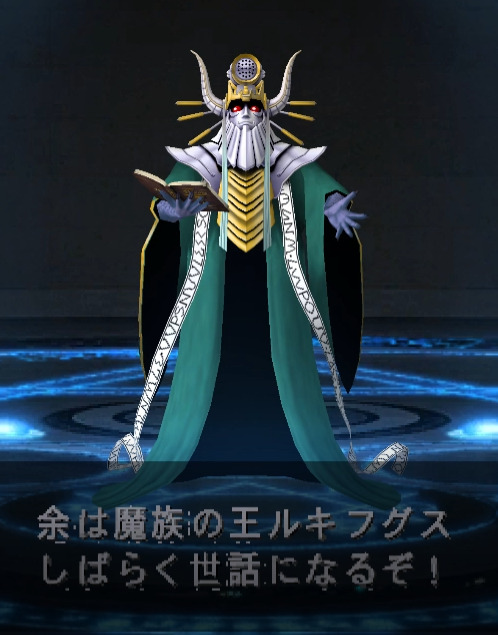
Thank you for your continued support of my blog. Normally I would just post a GIF set and be done, but the demon I had planned turned out to be a huge pain in the ass so I thought I would share the pain. All images under the cut. Spoiler warning and flashing/bright lights warning.
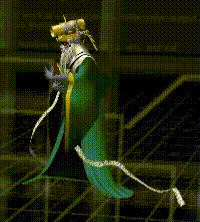
I wanted to make walking/running GIFs of Lucifuge, a high level Tyrant of the Dark-Chaos alignment. He was one of the few remaining unique models in the game. Interestingly NINE appeared to be his playable debut, similar to Gemori and Seth. All three originally appeared in Shin Megami Tensei II as NPCs and would only gain stats in later entries.
NINE, like the name suggests, has nine different potential routes. The usual Law-Neutral-Chaos alignments make up only one axis of endings, with the other being comprised of Dark-Neutral-Light for a total of nine combinations. From what I can tell by following guides online, you must be on the Dark-Law path in order for Lucifuge to appear and fight you. I realized he had to be defeated to be fused when none of the supposed recipes to make him worked. (Notice the words that are bolded, they’ll come in useful later.)
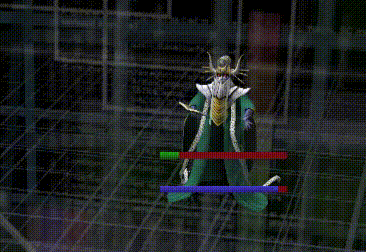
So I loaded an earlier save from before the alignment lock and got to work getting to the Lucifuge fight, which involved threatening to kill my in-universe little sister to gain enough Dark points for the route change. Prior to fighting Lucifuge himself, I had to fight the ugliest NPC in the entire game who supported himself with 3 Legions and could instantly kill me with Budufyne. Cool. I forgot to take a picture of him. Once he died, Lucifuge showed up to fight me. He was also a pain, as I was down to one demon from the previous fight and he nuked them immediately. But eventually he died, and I was able to proceed.


Now, this is all taking place in the final chapter of NINE so obviously a lot of plot stuff is popping off. Raguel the angel shows up to throw an energy ball at NPC lady Feris, and to serve as the next boss fight. Raguel was much less difficult to defeat.
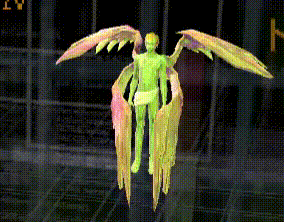

Raguel’s dead, but this priest isn’t here to deliver a eulogy. The next big player reintroduces himself by throwing an energy ball at Raguel in a bit of poetic justice for Feris earlier, then asks us to join him on the roof. Damn, everyone’s throwing energy balls in here. Here’s a WEBM version if you’re into that shit.
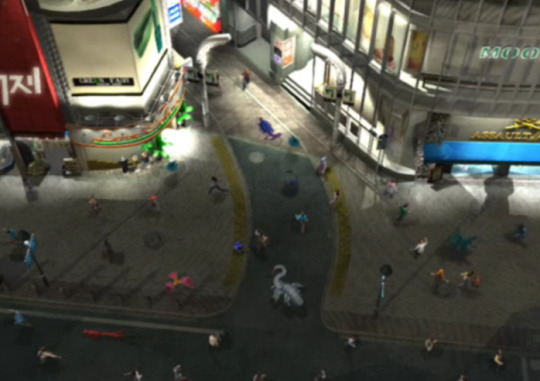
We witness the digital world going to shit on the rooftop and get offered a choice between siding with him or against him (& Sumire, who you can kinda see in the right-hand background).

I choose against and we begin another boss battle. This priestly fellow turns out to be Sariel, another angel, except he’s a fallen angel and at odds with his fellow Shin Megami Tensei II alumni Raguel. Neither of the fights after the Legion Guy-Lucifuge combo were nearly as difficult, so Sariel also goes down. I say “neither” but I forgot to mention I also killed a childhood friend, Baraki, inbetween the Lucifuge and Raguel fights. But that’s not important.

What’s important is I got through all the bosses, and got to a point where I could finally fuse Lucifuge. Which I did, easily.

Finding a place to take GIFs of Lucifuge walking would be tricky, because at this point in the game my first pick, Shinjuku, was no longer an option. Maria, the holy mother, is waiting there to take me to the domain of Yaldabaoth, the false god, so that I may kill him and bring about the reign of Law, and I really didn’t feel like doing that. Even if it would mean seeing her cool not-a-statue-with-dinosaurs-on-it design that never appeared again.
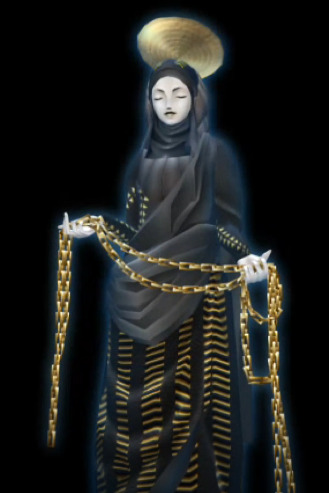
Instead I made my way down to Roppongi, which usually has great music but during this endgame bit is instead silent. I went to summon Lucifuge into my party and got a message I couldn’t. Oh, of course, you can’t have Law demons and Chaos demons in the same party. Doy. Duh. You could never have party that was mixed Law and Chaos in these old SMT games. So I removed the Law demons, set my Navigator demon to neutral and then tried to summon Lucifuge again.

The message remained. What could the issue be? Why was I unable to summon Lucifuge into the overworld? What was this last hurdle between me and Lucifuge? If you have your notes from paragraph 2 and 3, you may want to consult them now. There’s also a hint in the previous paragraph! Put on your thinking caps. Get out your detective pipes. Don’t scroll past Sukuna Hikona until you’ve made a guess. Are you sure of it? Really sure? Alright. Here’s the solution to this locked room murder mystery that robbed me of half an hour of my time:

YOU CAN’T SUMMON CHAOS DEMONS AS A LAW-ALIGNED PLAYER, EVEN IF THEY’RE LOCKED BEHIND THE LAW ROUTE.
For some reason I guess I assumed this wouldn’t apply to me, and I continued down the Law path subconsciously knowing I wouldn’t be able to actually show off the demon I was dedicating so much time to obtaining. Thankfully, once I realized this I thought to redo this endgame stretch from ANOTHER back-up I had.

And it worked! Instead of fighting Sariel I gave him a disc, murdered Miranda and was able to summon Lucifuge.

Lucifuge offers to hug it out in apology for causing me such pain. I still couldn’t make gifs of him in Shinjuku because Maria is still there, but instead of trying to take me to Yaldabaoth’s realm she’s trying to kill me. And I really don’t feel like taking her on right now. Not when she’s throwing out chains and sefirots like this:


Shin Megami Tensei NINE is a game that exists. Thanks for enjoying my blog. Hopefully I’ll have some neat stuff by the time there’s 500 of you following me.

Also somewhere along the line I did a shooting-energy-ball-gesture at my little sister to disarm her, who was trying to kill me. Probably because I threatened to kill her earlier. Oh well. Get logged out, idiot.
54 notes
·
View notes
Text
The Digimon Survive-esque evos for the messiahs continue
With the messiahs fighting alongside their Digimon, they evolve based on the main attack type you have been using since their last form. These also correspond to the vaccine, data, virus trio of types. When this idea suddenly came to me I had to redo all of them in this style.

I wanted to stick with exclusively older Digimon for him. In universe, as a reference to mega being an addition he would probably only go up to ultimate during the game events and have a mega later like in his boss fights in other games.

Hackmon is already perfect for him. I can even imagine Beth having a Sistermon to go along with it. I imagine Paladin Mode is gaining power from Kazuya’s partner that’s still hanging around (I think the Cerberus is SMT II is the same one). The completely white sprite is Jesmon GX.

ChaosGallantmon is a higher because it’s the result of a biomerge. I used AncientGreymon because Susannomon fits more for Nahobino.

Considering he’s a soldier giving him D-Brigade Digimon makes sense to me.
These two are from part 1. I thought it would be awkward if they weren’t here. I did their post yesterday.


Part 1 for Flynn and Nanashi’s explanations: https://www.tumblr.com/thebladeblaster/757954110030053376/i-know-i-said-i-would-never-change-flynns-line

Susannomon would be available after beating Demi-Fiend. I imagine he uses biomerge digivolution.
Warning: SMT V Vengeance spoilers

This is for when Nahobino temporarily has Tsukuyomi. I wanted to fit Kagazuchimon in one of the lines.
#shin megami tensei#smt1#smt2#smt3 nocturne#smt iv#smt4a#smt iv apocalypse#smtiv#smt5#smt v vengeance#strange journey#digimon#kazuya#the hero#aleph#hawk#demifiend#hitoshura#naoki kashima#smt flynn#nanashi smt#nahobino#gabumon#hackmon#guilmon#ryudamon#goblimon#strabimon#my crappy edit#au
8 notes
·
View notes
Note
SMT IV, SMT II, and Disco Elysium
Alright! This one will take a while, but I have many opinions for each of these. I hope nobody minds me doing repeats of certain characters though. My feelings on Daleth are vast abd complex:
SMT IV:
My Dearest Blorbo: Issachar. He toes the line between Blorbo and Glup, but I think his prominence in the prologue of IV secures him a spot as my favorite character from the game. I would kill to get a short prologue type deal where you get to play as him when he's training with Flynn or cavorting with demons.
My Most Gentlest Scrunkly: Has to be Alice. She was with me the entire rest of the gane from when I had her in IV and I wish her all the best. She doesn't have Scrunkly energy of her own, per se, but she is my Scrunkly as per the criteria of the ask.
Scrimblo Bimblo: Probably Issachar again. He doesn't get nearly as much spotlight as I, personally, feel he deserves.
The Glup Shitto I have chosen: Commander Hope. Like I said with Issachar, this can really be interchanged between the two. However, what makes Hope more obscure than Issachar is that you never get a boss fight against him, and thus never get to see his samurai skills in action... Unless you buy the DLC for Apocalypse where they make him green.
The Poorest of Little Meow Meows: How many times can I put Navarre here without it becoming annoying? I love him, he's like another of my meow meows but even more pathetic and unlikeable, I love him. I actually like him even more alive than as a ghost, so yay for base game Navarre! Earning the award for most useless holy knight.
Horse Plinko: Also Navarre.
Eeby Deeby: Abbot Hugo, absolutely, for sure.
SMT II:
Blorbo: Daleth, from my shows. I wish I could play as him.
Scrunkly: Beth. She's the most Scrunkly character in the game, I'm pretty sure. She's just shaped that way.
Scimblo Bimblo: Maybe Madame would fit here? If she's too popular, then I'll throw Daleth out here again.
Glup Shitto: I don't think I have a Glup Shitto for SMT II... Maybe Anoon. I love her, even if she has questionable taste in men. Yes I love Daleth too, but this isn't about me in this one case.
Poor Little Meow Meow: ... Daleth again? I'm sorry everything on this list has been Daleth or Daleth related so far, but I just fucking love that green bastard.
Horse Plinko: Still Daleth. My feelings on this idiot bastard are plentiful.
Eeby Deeby: Puck. Goddamn fairy and his status ailment giving, run around the dungeon, time wasting, no good lousy self. Ten superhells.
Disco Elysium:
Blorbo: This is the toughest question on the list so far. It's either Harry or Kim, but can I rightfully put one above the other? Kim gets it, but only because Harry is just so pathetic that I can't help but think of him as poor, and little, and perhaps a meow meow.
Scrunkly: A certain stick insect. :)
Scrimblo Bimblo: La Revacholiere. I am enraptured every time she speaks, through whispers on the wind and chills up my spine.
Glup Shitto: That one Moralist guy you meet in the young man's room. He's hilarious and tone deaf and I hate him so much but I want to put him on the spot to defend his bs centrism so bad. I wish you could see him more than just the once. Some Sunday Friend.
Poor Little Meow Meow: Here he is!!! Right where he and his skills need to be, one Harry duBois. What a fuckin guy. This old man *is* my poor little meow meow. I will not have his status disputed.
Horse Plinko: Cuno, but only because he would actively fight back. You can't force the Cuno into a Plinko he did not already fully intend to enter. Cuno is in the Plinko of his own design. The Cuno *is* the plinko, pigs all fucking up on the bars, devoured by the flames shit. Real fucking inferno style shit.
Eeby Deeby: Is it wrong to put a dead man here? Lely, with your beautiful eyes and horrible everything else... You get to go here post mortem.
And that's all of it! Thank you for asking!!
#smt iv spoilers#smt iv#smt ii#smt ii spoilers#disco elysium#disco elysium spoilers#de spoilers#long ask#daleth my beloved#daleth my beloathed
11 notes
·
View notes
Note
After beating Devil Survivor 1, I’m moving on to Devil Survivor Evangelion 2. Before I go, I’m just gonna say that I find it really funny that Naoya, the chaos representative, actually has the least amount of casualties in his route.
Well first of all, congrats on beating the game! (๑✧∀✧๑) I hope you enjoyed it!! Also, I hope you have fun with desu2!
I've talked about this on my blog somewhere, but Naoya's 8th day being split into sub-routes does a really great job at fleshing out chaos as an ideology.
A lot of megaten chaos reps subscribe to what I like to call "bitch chaos" [loud glaring at Chiaki] where they root for a "might makes right" mindset and... that's it. Head empty, only anger.
However, there’s a more subtle interpretation that doesn’t get enough attention imo. Those who are in positions of power don’t have to abuse their abilities in order to rule over others. Nothing in the chaos ideology says that you have to use the power of demons for selfish purposes. Just that you side with the demons for ultimate freedom. That freedom can be on an individual level (where we see the “might means right”), or can be used for humanity as a whole (focusing more on freeing humanity from YHVH’s rule).
That’s where the kill/no kill sub-routes in Naoya’s eighth day come into play. Both of those routes represent the two different interpretations of chaos.
Anyway, before I go too deep into a rabbit hole of why I think Naoya's 8th day is so great, I'll just close off with saying that while the Gin/Haru route is considered the true route of the original game, I do feel that Naoya's no kill ending is the true ending of Overclocked. The game does a really great job in following SMT II's footsteps in showing that chaos actually can be good.



In both Overclocked and SMT II, you can use chaos to free humanity from YHVH's tyranny, but work to rebuild society afterwards-- this time, on your own terms.
#devil survivor spoilers#devil survivor#desu#desu rambles#answered#amelia rambles#i've always considered desu to be like.. an honorary 90s megaten game#there's just something about the world building and handling of alignments that's very reminiscent of smt i/ii#but that is for another post..#anyway thinking about the mutants reminded me how much i hate everyone in nocturne#all of your reasons SUCK the only good one is futomimi's#and in turn you all SUCK because none of you sided with him#i would very much like to throttle chiaki with my bare hands#if nobody got me i know futomimi got me can i get an amen
16 notes
·
View notes
Text
I just Finished Majin Tensei II
SPOILERS BELOW

The Game was pretty fun, the story was amusing, the cast was pretty likable in my opinion and it actually showed new things about how demons from both Law and Chaos live in their society and how their politics works with the Tetrarchy when they are not at war with each other, it also gave an angle I was wanting to see, like the demons you kill on Amnesia(Law world) were treated like you were actually killing actual people, same thing for those in Paranoia(Chaos/demon world), which is rare in Megaten because usually killing demons is glossed over, also...

Press F to pay respect, I do feel like there was some difference between the way Satan(Light-Law) acted in SMT 2 and the way Satan(Dark-Chaos) acted in Majin tensei II.
The ending was pretty sweet too.
2 notes
·
View notes
Text
WOOOOO FUCK YEAH DIANA GET IT BLUE SMOKE OR SMT YEAHHHH
0 notes
Text
SMT V and mythology
While many game franchises make use of mythology to some degree, Shin Megami Tensei is arguably the only one known for extraordinary dedication to the source material, with not only designs but even major plot points often being lifted directly from mythology or at least from literature (of varying quality) pertaining to it. In the following article I will look into how SMT V fares in that regard, relying chiefly on the portrayal of some of the plot-relevant demons, though I will also evaluate some of the central plot elements of the game. It naturally contains unmarked spoilers.
Lahmu

Doi’s Lahmu and a terracotta relief of a Lahmu As some of you may remember, my initial view of Lahmu was rather positive. The design, by Doi standards, at least tries to capture the essence of the creature depicted. True to the meaning of its name (which in Akkadian means “hairy one” - not “muddy one” as you might incorrectly learn here and there online), it certainly is hairy, and I guess it does look sort of like a nondescript aquatic creature (or like a globster, at least...), which fits a being often associated with the subterranean sea from Mesopotamian beliefs, Apsu (or Abzu, or Engur). It’s not a 1:1 copy of the real artwork, taking a much more abstract approach to the idea, of course - as you can see above, the real Lahmu was pretty similar to medieval woodwose or contemporary bigfoot and yeti in appearance. However, I think the design nonetheless does its job and, quite importantly, doesn’t look out of place next to associated figures designed earlier by Kaneko: Tiamat (probably the only depiction which tries to follow the completely bonkers descriptions in Enuma Elish instead of succumbing to the DnD influence and incorrectly reinventing Tiamat as a dragon - major improvement over the boring SMT II design), Apsu and Mushussu. I do have an issue with the compendium asserting Lahmu was depicted as a snake though, as that wasn’t a thing at any point in time.

While I have nothing but praise for the design itself out of context, and would actually love to see it used as a generic demon in future games, that’s where the good ends. The writing completely fails at capturing what Lahmu actually is. Frankly, the very idea of making Lahmu a major player in a story feels rather thoughtless - imagine trying to do the same with kikimora or something along these lines.. It doesn’t help that there is no shortage of major Mesopotamian figures with no megaten presence. It’s also rather weird that the game seems to portray Lahmu as a unique specimen, since in Mesopotamian myths this name refers to a category of beings, not to an individual, with some very rare exceptions I’ll discuss later. Lahmu isn’t exactly major by any means, but it’s nonetheless pretty easy to judge accuracy in this case. Excavations have provided us with quite literally heaps of evidence, making it rather clear what this bizarre hairy entity meant to people who first came up with it. How come? Rather than to the world of gods, lahmu belonged to that of apotropaic and household spirits - more a Mesopotamian answer to zashiki-warashi or domovoi than something comparable to major gods of classical mythology. Mesopotamian sources generally avoid associating lahmu with both the textual symbol of divinity, the so-called “divine determinative” or dingir, which preceded names of gods in texts, and with its pictorial equivalent, horned headdress. As an apotropaic creature, Lahmu was not perceived as malevolent, but rather as a protector of the household, keeping it safe (through violence, if necessary) from beings less favorable towards mankind. The role of many other fantastic creatures was understood similarly - kusarikku (bull man), mushussu (lion-dragon) and many others were frequently invoked to protect houses, and figurines of them were found buried under doorsteps in many ancient settlements. In addition to keeping evil away, they were also meant to invite good into the house. Lahmu are generally kept apart from the categories of malevolent beings (utukku lemnutu), though it is possible in some cases they were imagined as former enemies of major gods who repented and entered their service. In art lahmus sometimes also fight each other, but the meaning of this motif is unknown and doesn’t necessarily represent combat between good and evil, as summarized by Frans Wiggermann, an Assyriologist who wrote the most extensive source to date on the topic of Mesopotamian apotropaic creatures:

A slightly different, non-standard take on Lahmu can be found in two sources: Enuma Elish, the 1st millenium “epic of creation” (just one of many - hardly some grand central scripture of ancient Mesopotamia) and so-called “Anu theogony,” a list of ancestors of the sky god Anu present in some of the god lists compiled by ancient scribes, including the famous An-Anum. There the name refers to a singular being, paired with an artificially created (ie. not based on preexisting beliefs) feminine equivalent not attested elsewhere, Lahamu. Contrary to what the V compendium claims, Lahamu does not appear alongside Lahmu otherwise - the only apotropaic beings commonly appearing as a male-female pair are the scorpion people. However, even with the above taken into account, the characterization in V doesn’t reflect the myths: this “ancestral” Lahmu is likewise portrayed as benign in the Enuma Elish, not as a vanquished evil god. Indeed, he lines up with other decidedly not malevolent deities, including the usual heads of the pantheon, to praise Marduk after his victory. Additionally, it’s hard to imagine this tradition was particularly influential, as even in the Enuma Elish itself the regular Lahmu still makes an appearance, listed among various supernatural beings given a new backstory as Tiamat’s creations, alongside other usual suspects like mushussu, kusarikku, scorpion men and so on. What inspired the SMT V take on Lahmu, then? I personally have no clue, beyond being able to say with certainty that it had very little to do with Mesopotamia. A friend made a convincing case that we’re simply looking at the work of writers whose frame of reference aren’t actual primary sources or even just “occult” books, but the isekai genre. It would certainly explain the baffling use of the name for a completely generic “ancient demon lord” entity. It’s not even the authentic Lahmu wouldn’t work as part of Sahori’s arc, arguably it would strengthen it and give her more character without what in my opinion constituted a pretty lame copout. Speaking of sources: it needs to be stressed that it seems Doi’s only point of reference (based on almost word by word quotes in the design commentary), as well as seemingly the only source used as basis of the compendium entry, is the Japanese wikipedia article about Lahmu, which is, to put it very lightly, not great, and relies on sources which were already outdated before WWII, which formerly dominated the English one too. Many wikipedia editors have a weird love of resources which were discarded by most people 50 years or so ago no matter how many credible journals and monographs presenting the modern consensus and research which lead us here can be accessed freely. Of course, it generally does not seem like the staff of SMT V cares much about Mesopotamian mythology, judging from the contents of the Cleopatra dlc which just declares Mesopotamian gods were damned en masse (why is that in a dlc and no mention of it is made during the Ishtar boss fight is beyond me). Presumably Enlil and friends were not cool enough for Bethel, which seems to roughly be “every mythology normies know in one place,” a far cry from the composition of organizations in past Megaten games which usually mixed the famous with the obscure in unexpected ways (Soul Hackers’ combination of the well known biblical narrative about fallen angels and Algonquin folklore comes to mind as one example). There is also this absolute horror which I will leave without comment:
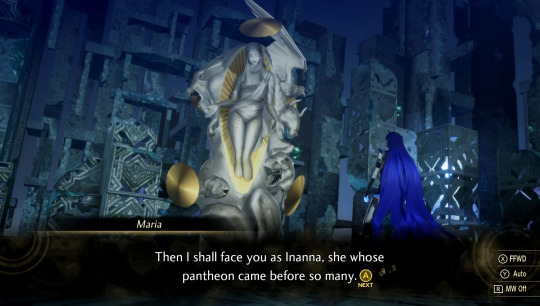
Well, at least she is not here to be presented as a corrupting influence on little girls this time, I guess. Surely they fared better when it comes to less ancient and less obscure myths, right? No way for a Japanese studio to mess up adapting the classics of Japanese mythology like Kojiki and Nihon Shoki? Well…
Tsukuyomi and Amaterasu
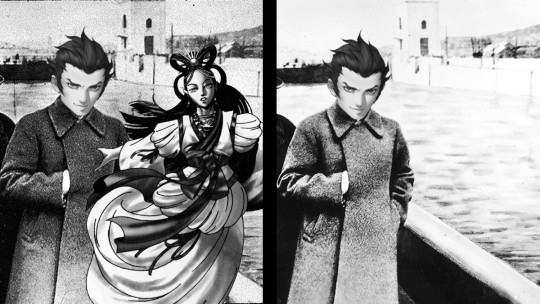
Perhaps the inclusion of Amaterasu in this entry is somewhat surprising at first glance. “Antonia,” you might ask, “why is she here considering she is not in V at all?” Technically that is right. That’s actually the problem, though. The game essentially writes her out, and then turns Tsukuyomi into a bootleg Amaterasu for no good reason. V heavily depends on the concept of Amatsukami and Kunitsukami, rooted in two classical works of Japanese semi-mythical historiography, the Kojiki and the Nihon Shoki, completed respectively in 712 and 720. In theory, the distinction seems clear - Amatsukami live in heaven and Kunitsukami on earth, as expected based on the meaning of these terms - but in reality the use of them was often ambiguous in religious practice and legal documents. For example, in Ryō no gige, a legal commentary composed during the reign of emperor Junnin, the distinction is simply based on the location of the shrines dedicated to specific deities. An argument can also be made that it was hardly the central concern of both clergy and laypeople throughout much of Japanese history. In sources from between the 11th and 16th century - the time commonly referred to as Japan’s “medieval” period in western literature - kami are usually instead classified based on their placement within syncretic Buddhist networks:
as representations of some primal form of enlightenment
as secondarily enlightened through own salvationist effort
as unenlightened, and in some cases hostile to Buddhist teachings
These categories tend to be described with limited, if any, concern for distinction between amatsu and kunitsu; for example, the Ise (Amaterasu) and Suwa (Suwa Myojin = Takeminakata, kunitsukami par excellence) shrines both held their enshrined gods to be examples of the same category of deities. Of course, classification varied between shrines too, and even parts of a single temple complex could have divergent views on classification of the same deities. Putting this digression aside - the concept of Amatsukami is heavily tied to Amaterasu in the specific mythical texts SMT generally draws from when it comes to depicting Shinto deities, and the only other contenders are various poorly defined primordial entities, for simplicity often omitted in adaptations. As a result, members of the Amatsu race are all demons tied to narratives pertaining to Amaterasu, the only exception being Hinokagutsuchi (not pictured below).

Omoikane coordinates other deities while Amaterasu hides in the cave, and later serves as her advisor in other situations.
Tajikarao seals the cave to prevent Amaterasu from hiding inside ever again.
Takemikazuchi is one of the deities sent to pacify the earth in Amaterasu’s name in the Kojiki; in the Nihon Shoki he instead insists on joining Futsunushi, appointed to fulfill a similar role.
Ame no Uzume (moved to the Amatsu race in IV) rather famously performs a song, dance and striptease montage to lure Amaterasu out of hiding.
Ame no Torifune is one of the names for a nebulous “boat-god” appearing in two myths: once when Hiruko is abandoned by his parents, and, in varying roles, in the land transfer narrative. In the Kojiki, Ame no Torifune assists (transports?) Takemikazuchi due to his journey to earth.
Additionally, a number of deities who are according to myths classified as Amatsukami are included in other races, but are identified as such in quests:
Ame no Futotama (added in Soul Hackers, which didn’t have the Amatsu race in it; consistently in the Enigma race), who performs various rituals meant to make the effort to lure Amaterasu out of hiding successful. In Kogo Shui, a chronicle of the Inbe clan composed in the early 800s, he is presented as the principal force responsible for ending her self-imposed exile, at the expense of other deities such as Ishikoridome (the tutelary deity of mirror makers), probably because the intent of the chronicler was to restore the high status of his family. In Strange Journey he appears as Uzume’s wingman one of the gods seeking to bring Amaterasu back home. He explicitly identifies himself as an Amatsu in IV, where he likewise appears in connection with Amaterasu.
Futsunushi (normally part of the Kishin race, in V - Wargod) - true to myths, V explicitly has him call himself an Amatsukami. In the Nihon Shoki land transfer myth he acts more or less as enforcer of the will of the amatsukami figureheads, that being the primordial deity Takamimusubi and Amaterasu, but not Tsukuyomi; somehow it is not much of a problem to him in his side quest that Amaterasu is nowhere to be found and a guy she is, as you’ll soon see, not very fond of, is bossing everyone around…
Amaterasu’s rule over the heavenly gods is established when either Izanagi alone or Izanami and Izanagi as a pair after her birth. Two aspects of the myth vary: whether the children are born the expected way or created by a supernatural act of Izanagi alone, and what areas are assigned to them to rule. In one version Tsukuyomi rules the “sea plain” and Susano-o the earth (or rather - is meant to rule it, since he instead engages in the usual Susano-o antics and refuses to do his job); in another Tsukuyomi rules a nondescript land of the night (in kokugaku commentaries from the 19th and early 20th century sometimes identified with the “land of Tokoyo” which many readers of my blog likely know from the story of the “bug of Tokoyo” and Hata no Kawakatsu) and Susano-o - the sea plain. Finally, in yet another Nihon Shoki passage Tsukuyomi is sent to the heavens alongside Amaterasu - a role which however seems to be temporary, as you’ll see very soon. While it technically makes sense to group Tsukuyomi with the Amatsukami, since he is indeed a god residing in the same location in at least one version (for a time), it’s important to stress that in religious worship he generally lacks a strong connection to Amaterasu. At Ise, where her main shrine is located, and in relevant religious literature, she is associated first and foremost with Toyouke, a deity connected to food production whose gender seems to vary between sources. Tsukuyomi technically has a minor shrine nearby, but in at least one text from Kamakura period Ise its divine inhabitant is instead said to be one of three obscure “magistrates” serving Amaterasu (Suikan, Chikan and Tenkan). On top of that, Amaterasu and Toyouke were collectively referred to as the sun and the moon in some documents, an association based on their connection to the diamond realm and womb realm mandalas. In myths Tsukuyomi is very rarely a dramatis persona, generally speaking. In the Nihon Shoki, aside from a number of accounts of his birth (inevitably side by side with his more notable siblings) and a handful of references to legendary or historical events involving humans performing Tsukuyomi-related oracles he basically only appears in one myth… in which he gets banished from heaven for murder. The story is neither particularly detailed nor a part of any longer cycle unlike that of conflict between Amaterasu and Susano-o. The premise is fairly straightforward: Amaterasu sends Tsukuyomi as her representative to visit Ukemochi, a goddess of food. Ukemochi prepares a banquet for her guest by producing various consumables from her… bodily orifices. Tsukuyomi is profoundly disgusted by this and in a fit of rage kills her for this affront to his dignity. He then ascends back to heaven and tells Amaterasu what he did; in a fit of (arguably more justified) rage she banishes him for it and, presumably, lives happily ever after. This myth is most likely meant to serve as an explanation for separation of night and day. I’ve noticed that a number of secondary popular sources in English claim Amaterasu and Tsukuyomi are spouses in this narrative, but so far I found no support for this claim - in both Kojiki and Nihon Shoki Amaterasu is pretty firmly unmarried, and I have yet to see any later myth where she would be associated with Tsukuyomi. At least one source from among the medieval Ise documents appears to indicate carnal relations occurred between Amaterasu and Toyouke (in this context male), though. It’s worth pointing out that at no point in either the Kojiki version or the multiple accounts listed in the Nihon Shoki does Tsukuyomi interact with Susano-o - conflict with him is entirely Amaterasu’s domain. In syncretic documents from Ise an additional cosmological dimension was added to it by making Amaterasu represent “Buddha nature” and enlightenment, and Susano-o the opposition to it. In V, though, the only conflict even just alluded to is between Tsukuyomi and Susano-o if you opt not to side with the former’s human guise. Not much material on Tsukuyomi can be found elsewhere, and especially not anything that would justify placing him in the position you’d expect his sister in, like in the case above. He’s briefly mentioned in the poetry collection Man'yōshū in relation to a potion of longevity - which to me seems like an echo of Chinese mythical motifs related to the moon, especially those related to Chang’e, but don’t quote me on that (chronologically it definitely would make sense, as Chang’e was already well established some 800 years prior to first attestation of Tsukuyomi). Famous narratives pertaining to the moon like Tale of the Bamboo Cutter or Hagoromo do not even allude to him. In terms of honji suijaku material, all I could find is a single instance of equation with one of the wisdom kings, in this context a minor satellite deity in a ritual. A theory which I personally think can be discarded on the account of its author being a Jungian psychoanalyst rather than historian is that of Hayao Kawai, who argued that Tsukuyomi was actually equally significant and purposely left somewhat featureless, so that struggles between opposing principles can revolve around him. The fact that he appears in no myths about conflicts between Amaterasu and Susano-o and that his only myth portrays him as rather violent feels like a considerable setback, but as we can learn from his article The Hollow Center in the Mythology of Kojiki he seems to have a kokugaku-like bias. He asserted that Kojiki matters more. According to him Nihon Shoki was a “political” work while Kojiki - simply some primal manifestation of truly Japanese spirit not bound by such trivial matters as “historical context.” Note both works were composed by a similar cadre of people at around the same time, and that Nihon Shoki is the one which usually lists multiple versions of each event, even if they’re contradictory, which by the standards of 8th century royal propaganda - which both of these books ultimately are - seems much closer to unbiased to me.To sum up, unless I’m missing something, Tsukuyomi only received a boost in prominence in popular imagination due to modern popculture. I don’t exactly think Naruto and other similar media should serve as a point of reference for such matters, and as a result I see little reason to refer to him as prominent and even less for overlooking Amaterasu in favor of him. II recognized that:

In contrast with Tsukuyomi’s general irrelevance, it should be noted that non-Kojiki non-Shoki material concerned with Amaterasu recasts her (or, in some cases, him, it can get complicated) in a variety of major cosmogonic roles (often arguably giving her more personal agency than she has in many Kojiki and Shoki passages): as a creator deity equated with Brahma (Bonten; Amaterasu effectively displaces own parents from their Kojiki/Shoki role which is rather funny), as a judge of the dead associated with king Enma and Taizan Fukun, as an opponent of Mara (unlike the Buddha, she seemingly opts to strike a deal with him), and more. She has no shortage of rarely discussed myths, many of which, by the virtue of combining elements from Shinto with Buddhism, Taoism and even Hinduism feel very suitable for the syncretic settings of Megaten games.
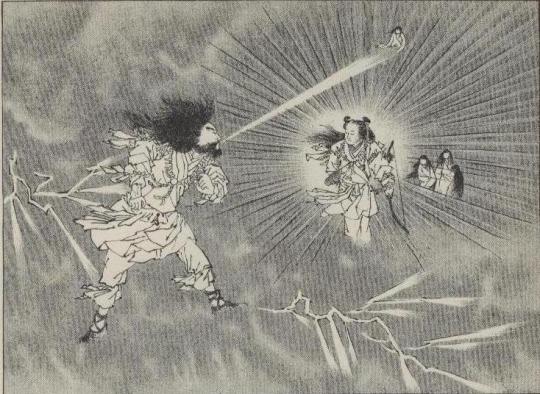
Disguised Amaterasu confronting Susano-o (public domain) Even assuming the decision to use Tsukuyomi over Amaterasu was tied to the idea to make the deity’s alter ego the Japanese prime minister, the entire idea feels hard to justify. Let’s even assume that a female prime minister would be too much of a suspension of disbelief (unlike, you know, gods, angels and horrid tokusatsu characters) - it still would be easy enough to declare he’s actually Amaterasu in disguise, seeing how even in the Kojiki/Shoki alone she does that on occasion, namely when she plans to confront Susano-o after hearing he’s heading to her domain. The fact she’s female in the Kojiki and Nihon Shoki (and in many other sources) didn’t really stop Amaterasu from appearing as a seemingly male figure, either. She is no stranger to being equated with male figures in syncretic context, including Dainichi (Vairocana), Aizen Myo-o (one of the wisdom kings, connected to lust), and even king Enma. It has even been proposed that the easily recognizable modern image of Amaterasu as a maiden in white robes is partially derived from that of distinctly male Uho Douji, one of her Buddhist alter egos. I find it peculiar that not just Tsukuyomi but also every single other figure you’d expect to feel the need to mention Amaterasu just… doesn’t. Futsunushi and Yatagarasu do not, neither does any of the kunitsukami. Perhaps the writers felt insecure about their weird dream prime minister/toku reject (I actually do not think Doi’s “toku” designs are good toku designs but that’s another matter) original character to such a degree that they worried the mere mention of Amaterasu would be too much for him not to fall apart in the eyes of the players? Hard to think of a sensible rationale. Until proven otherwise I see no reason to entertain the possibility that Tao is Amaterasu, also, as this identification is not made - or even alluded to - in the game, and her unique race name, Panagia, is related to Mary (especially in the Eastern Orthodox Church). The case of Amaterasu and Tsukuyomi seems to be a part of a bigger pattern in V - whenever possible, female mythical figures are sidelined. Vasuki being Shiva’s main supporter even though Parvati is right here is another example. I’d personally count the Melchizedek quest too, as it basically reassigns Anat’s mythical role to the archangels for the sake of… a shallow Nocturne reference, I guess? One which doesn’t even work too well because Baal Avatar in Nocturne worked only in the context of this specific story and has precisely 0 reuse potential.

As a side note, since I’ve already mentioned one of the quests pertaining to him - Baal once again does not fare well in general, ultimately serving as an antagonist for Demeter, which on an unintended meta level feels like the conflict between what made Megaten a truly unique and remarkable franchise and its current direction. As usual, he gets to exist to hype up fan favorite Beelzebub for no real reason. While Kaneko’s design will likely forever remain one of the greatest and most accurate depictions more recent than the late bronze age, it seems like Baal’s character will remain detached from it. Which is a shame because Megaten could basically pull off a Baal cycle side quest at this point, considering a large chunk of the cast already appears in the series. I think IV actually came pretty close to doing something interesting with Baal for once by having him pose as Gozu Tenno, the most major of Susano-o’s Buddhist associates and/or alter egos, but ultimately that premise was wasted on more Beelzebub instead, rather than on a fun exercise in comparative mythology. If you ask me it would make for a better twist in that quest to have Susano-o in it than Beelzebub, but alas. Luckily, V has Susano-o in a major role! Surely that resulted in something worthwhile, right?
Susano-o Aogami

Tragically Susano-o himself fares no better than his siblings in this game. Donning what seems like the combo of a bodysuit and a tailcoat, he provides the player with rather characterless advice through the game. The identity of the baffling “metal man” teased months ago had been a subject of much debate, with proposals as varied as the Demi-fiend, Indra (not to be confused with Indrajit!) and Marduk all coming up in fan theories I can remember off the top of my head. Susano-o seemed like an improbable option since he, after all, already has a popular, well established design. Sadly that was not enough to spare him.
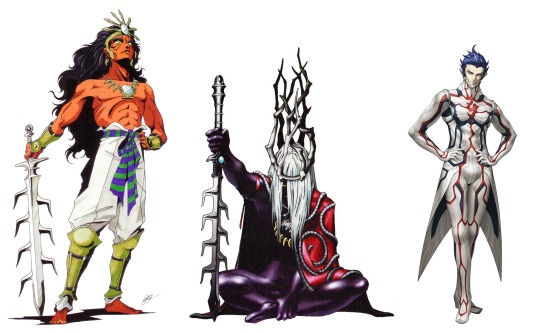
The design, to put it lightly, doesn’t go well with either of Kaneko’s Susano-os, who do go pretty well with each other. So well that I wonder if the idea was to simply depict Susano-o at two different points in his career, especially since the peculiar motif on Devil Summoner/Soul Hackers Susano-o reminds me of his connection to the mysterious “land of roots,” Ne no Kuni, known for example from the myth where Okuninushi has to confront him in order to marry his daughter. While Kaneko based his Susano-o on traditional portrayals and on a variety of famous artifacts, such as haniwa figures depicting the everyday clothing of Kofun period Japan and the famous seven-branched sword (with one extra branch added), Aogami just looks like he’s wearing a spandex bodysuit covered in broken glass. The game waves off any inconsistency by declaring that Aogami is actually a robot clone with Susano-o’s essence, but it barely amounts to anything and much of the info (which... still doesn’t explain much, to be honest) is locked behind a paid dlc, specifically the Mephisto one. And even then, this weird decision is hard to justify, and the dialogue doesn’t really seem to deny that Aogami is meant to be the genuine article, judging from, for example, Tsukuyomi referring to him as brother. Neither feels like mentioning Amaterasu even though both of them are defined more by relation to her than to each other, of course. What makes Aogami particularly annoying is the fact that in myths Susano-o’s character is pretty well defined, and remains notably consistent between the Kojiki, the Nihon Shoki and other sources. It’s described in rather striking terms: “This god’s character was evil, and he often took pleasure in weeping and rage. Many people in the country died. Green mountains withered,” declares a section of the Shoki. His deeds are described as “filthy and wicked” elsewhere, as noted here. He is held as the archetypal example of an “araburugami,” a wild, raging god. His reputation is largely tied to the myth about his conflict with his sister Amaterasu. After a trial by pledge determines he can enter heaven, he commits a series of morally reprehensible acts, which slightly vary between versions, but generally involve messing up the heavenly fields, flinging his feces around, releasing the heavenly horses and so on. Amaterasu initially lets it be, but eventually reaches a breaking point and hides in the cave, plunging the world into darkness. What causes this also differs between versions, but generally is assumed to be connected to Susano-o killing and skinning one of the heavenly horses and throwing the carcass into Amaterasu’s room, either wounding her or killing an otherwise unknown servant. In a variant of the Nihon Shoki narrative she instead decides that the point of no return is Susano-o defecating in her room. Either way, the blame is on him and him alone for temporarily depriving the world of light. Various passages related to the aforementioned myths highlight Susano-o’s impetuous, raging nature. Poor anger management seems to run in the family, considering the already discussed myth about Tsukuyomi. It’s worth noting that in the Kojiki a very similar myth presenting Susano-o as the killer is included, though the food goddess is named Ogetsuhime instead. However, prior to the dawn of the kokugaku style of scholarship in the Edo period, which favored the Kojiki at the expense of other sources, I think it’s safe to say Nihon Shoki can be assumed to be the more widely known variant, and allusions to it are known from Heian period poetry. The other famous myth of Susano-o is the slaying of Yamata no Orochi, the eight-headed serpent, and saving the life of Kushinada-hime. While the hydra (a great design and pretty fun fight) is pretty clearly meant to be a stand-in for Orochi, Kushinada at no point in time comes up despite being in the game.
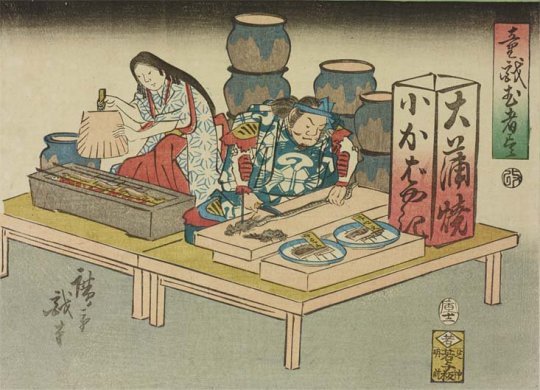
A humorous print showing Susano-o and Kushinada-hime selling grilled cuts of Orochi meat, from the collection Ukiyo-e Ōta Memorial Museum of Art A friend noted that Aogami is essentially what a Hollywood adaptation of Japanese mythology would be like, and I can’t really disagree with this point. His design even resembles the absolutely atrocious cgi bodysuits present in every single one of the interchangeable superhero movies. An additional sub-problem with the treatment of Susano-o in the game is Amanozako.

Amanozako as depicted by Toriyama Sekien, Shigeru Mizuki and Masayuki Doi She is a somewhat obscure yokai known chiefly for her inclusion in one of Toriyama Sekien’s famous “night parades,” where she is depicted as a hideous, enormous hag, true to her description from the Edo period encyclopedia Wakan Sansai Zue. As we can learn from these sources, she was believed to be a daughter of Susano-o created when he released the accumulated fierceness from his body. Another Edo period author, a certain monk named Myōryū, adds that she was the ancestor of tengu, though this is not mentioned anywhere else (granted, it’s not like Amanozako is, she is, as far as I can tell, an invention of Edo period authors) and generally speaking contradicts the common Buddhist view of tengu as people reincarnated in the realm of makai or tengudo for spreading improper teachings. It is however undeniable that Sekien’s portrayal takes many visual cues from the common image of long-nose tengu. Sekien’s portrayal in turn heavily inspired Shigeru Mizuki, the artist responsible for the modern concept of yokai, as you can see above. In V, Amanozako is instead a little girl. She doesn’t even have a tengu nose. The less said about her character, the better, but she is hardly a ferocious boogeyman and I am frankly unsure what motivated her creators. Given how much of her dialogue is like I am not sure if it’s a topic I want to explore further, so I will just say that to put it very lightly I am not a fan of the liberties taken at all. I would be uncomfortable with the dialogue even if it belonged to a character who actually fits the “little girl” role, truth to be told. I should note some criticisms miss the mark too. Some people seem to speak of the original with some weird reverence worthy of the infamous Woman’s Encyclopedia, treating hear as a powerful independent mother figure or something along these lines. This is wrong too. She's essentially someone’s oc boogeyman with two or three more or less tangible sources behind her. You don't need to make her into some grand example of transcendent "divine feminine" (a term which is generally an instant red flag in mythology discussion) to highlight that she shouldn't be what she is in V. Simply put, I believe women should be allowed to be one note boogeymen largely born from the sense of humor of Edo period night parade scrolls artists. Both Aogami and Amanozako, and to a degree Lahmu as well, seem to be part of a bigger trend in V, though not the same one as replacing Amaterasu with Tsukuyomi. It’s becoming rather obvious that the current staff behind the games seems to believe that turning the character of depicted figures upside down is what suits the series well. Examples of such changes include:
Dagda (IVA): from a fun-loving, fatherly god to skeletal nihilist
Inanna (IVA): I covered this matter in an earlier post extensively; from a pretty firmly childless goddess generally connected to the joyful aspects of sexual and romantic love (and to a plethora of other things, like war and royal power) to a pregnancy monster.
Demeter (SJR): arguably the worst one still, next to Inanna. From the archetypal mother to a ditzy little girl (“little rascal” as one of the devs put it himself, I believe). By the way, she talks with Zeus in V. Guess if Persephone comes up at all.
Susano-o (V): as discussed above: from a rebellious, very emotional and sort of unpleasant god to a stoic noble mentor figure.
Amanozako (V): from a monstrous hag to another little girl.
Lahmu (V): from a generally benevolent house spirit to a wicked demon lord.
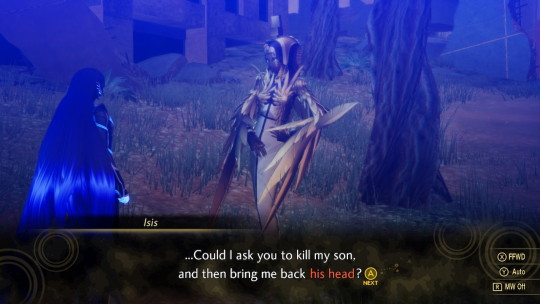
Sadly, in V this seemingly started to spread to how preexisting Kaneko demons are written too. A particularly sad case seen above is Isis, a figure normally defined by the love for her family. I must admit this annoys me for more than one reason:
she is a major figure with a lot of source material to use, much of this material being focused on her efforts to save (or elevate) Horus against all odds, even if it results in conflict with other major deities like Ra
she is one of the best examples of what makes Kaneko’s art work uniquely well, the perfect blend of a high fashion influence with reverence for the classical image known from ancient art
in IV she instead appeared in a great quest adapting the source material pretty well
it feels like this happens only to make room for a Doi demon (Khonsu)
In a way this is actually more egregious than something bad in every possible way at once, like Aogami, who to me seems impossible to salvage, unlike Isis, who is basically a problem only because the V writers went out of their way to make sure she’s “subverting expectations” or whatever goal their had in mind. It’s hardly the most notable example of wasted potential in the game, though. That title belongs to…
Nuwa

I saved Nuwa for last, as I figured it would be thematically appropriate to both start and end the part of the article dedicated to specific demons with ones I was actually genuinely excited for prior to actually learning about their full role in the game. While to put it lightly I am not enthusiastic about how she turned out in the game, I think she has one advantage many other new plot-relevant demons lack, namely a perfectly salvageable design. Nuwa is a cosmological figure attested in Chinese sources at least from the beginning of the reign of the Han dynasty (c. 200 BCE), and still reasonably famous today, even just judging from the amount of retellings of her myths aimed at kids I was able to find. Her exact role varies depending on time period, location etc., but the core remains about the same: she creates humans, often out of clay, and in a separate myth repairs the damaged pillar of heaven, saving mankind from various cataclysms in the process. The human creation myth has been at times used to justify social stratification, and many sources state that humans were not created equal by her - while she initially sculpted them carefully by hand from clay, she eventually switched to simply spilling mud with a rope. The first batch of humans were the rulers and nobles, these made from spilled mud became peasants. Another variant attributes the creation of humans to Nuwa feeling lonely. While to a western viewer Nuwa might seem like a Prometheus-like figure at first glance, I find it important to stress that she is not really portrayed as a rebel against authority in any myths.
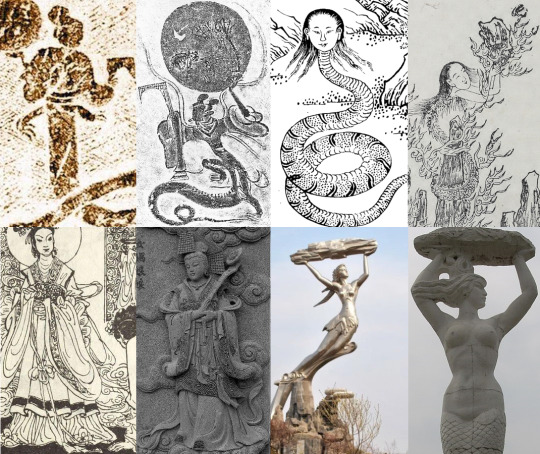
Nuwa portrayals from various periods of history Nuwa is commonly associated with snakes, and as you can see above many works of art, both historical and modern, depict her with some serpentine characteristics. However, their extent varies, and there are completely human depictions too (contrary to what Doi says). The pictures above are just a small sample, covering everything from the Han dynasty (the first two reliefs) to the present (the final two statues). I’m therefore not particularly bothered with keeping her form more or less human, even though I personally like the oldest version here the most. Unlike a number of other people online critical of V I also have no major issue with her outfit, it’s not really much more explicit than Kaneko’s Kikurihime and the like, ultimately, which are fine by me (I do think Kaneko was better at picking which demons to make “sexy” and at drawing attractive people than Doi is but this is another matter). I do think Doi’s trademark tip toes pose is pretty dumb, though, and there are scenes which feel like very awkward fanservice, particularly near the end of the game. I do not think “sexy Nuwa” is a fundamentally inappropriate idea given the fact that it is more or less what we learn from the classic Chinese novel Investiture of the Gods (I do not think Doi or anyone else at modern Atlus is familiar with it, though):
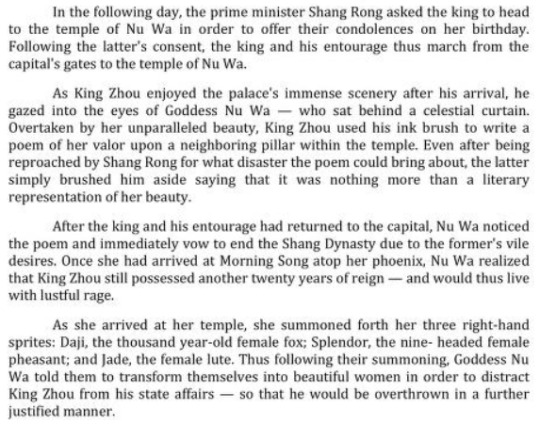
I also quite like her second form (Doi’s horror vacui tendencies notwithstanding) and find her unique skill to be one of the few genuinely fun ones in the game. It evokes imagery known from the myth - she even has a rope - and isn’t quite as annoyingly over the top as, say, Idun’s unnecessarily long animation. I think only Tandava is a cooler, more appropriate unique move.
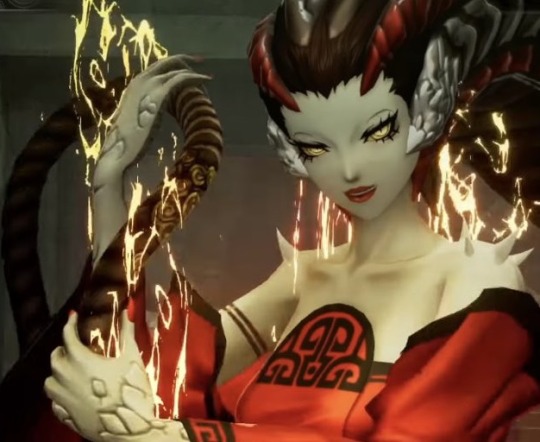
That’s where the good ends, though. Past her introduction - which I do have to admit is rather great, and it was a good idea to highlight it in trailers since it’s one of the few actually striking sequences in the game - Nuwa’s character is basically nonexistent. In terms of depth and complexity she’s somewhere between a heroine from the original DDS novels and Pascal, and I’m under the impression in 90% of her scenes you could pretty easily swap her for Hayataro. More on that later, though. Initially I wasn’t bothered by what seemed to be an absence of Fuxi. The association between them is actually hardly universal in primary sources. They are siblings and/or spouses at times, but it is also fairly common for Nuwa to be depicted as a solo act, and there are references to association with the Chinese “flood hero,” Yu the Great, in a number of texts too. On top of that in one account her helper in the creation of humans is Huang Di, tasked with sculpting internal organs. In Investiture of the Gods Fuxi if my memory serves me well isn’t even mentioned, and Nuwa largely interacts just with her femme fatale minions. Additionally in some locations she is associated with the Jade Emperor, appearing as one of his daughters. It was only the fact that Nuwa is basically stripped of context in the game that made me annoyed about the complete absence of Fuxi, since the result feels like an attempt at disconnecting her from her place of origin more than anything. Unlike the Bethel reps, Nuwa never mentions where she is from. She doesn’t allude to any figures from myths related to her either, and doesn’t interact with other Chinese demons (note that they had no problem with having Shiva, Odin and Zeus do that). A peculiar omission which makes me wonder to what degree she dodged the sort of completely awful characterization Xi Wangmu got in IV only by being basically void of context. I am tempted to compare Nuwa to Taotie in Raidou 2 as far as Chinese demons go - while he is ultimately not that major, he’s handled considerably better, gets to boast about his myths and all around feels like an actual character. I’m a huge fan overall:

Also, I love his dumb running animation. Back to Nuwa, I think her problems stem from a few interconnected sources.
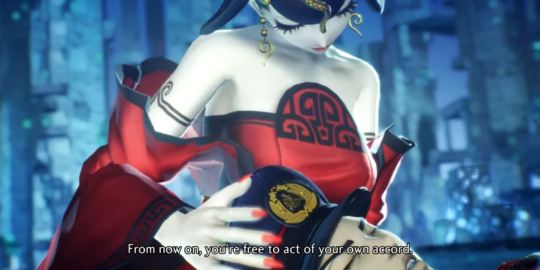
To begin with, it’s painfully clear she doesn’t exist to be an independent character, let alone a character representing some 2200 years worth of material. She exists to act as Yakumo’s pet. Imagine if Mastema was treated like that in Strange Journey... She only ever brings up creating humans twice, and makes no other references to her mythical role. She even barely talks about being a deity. Truth to be told, she hardly talks about anything other than Yakumo. I think this is to a degree a byproduct of this game’s treatment of female characters in general, both human and supernatural ones. While I’m not a huge fan of early SMT heroines, let alone the yet older ones, I think the later games have a wide variety of solid female characters, with Rei, Yuko and Zelenin being my favorites (though even minor characters could be great, Naomi from SH only appears in a brief vision quest but leaves quite the impression, for instance). Can’t say that about V. Nuwa isn’t even the worst offender in that regard, frankly. However, human characters are beyond the scope of this article. I thought that maybe it will turn out that her Bethel hatred (which feels more than justified tbh but the game never really goes particularly deep into this) would lead to some speech about her thinking other gods betrayed their purpose by serving said organization but instead it all boils down to "that's what Shohei wanted :)" and the true ending arguably makes it even worse. Am I supposed to assume she's a self hating nihilist or did the scenario writers forget halfway through she's meant to be a deity too? Why doesn’t she feel anything about presumably erasing every god connected to her, also? Do Fuxi, Yu or the Jade Emperor not exist in this setting? As a side note, I personally can’t stand Yakumo. Neutral is generally not an alignment I’m a huge fan of, but I think Strange Journey did pretty well in that regard. Commander Gore feels like a good character to compare Yakumo to since both are presumably meant to represent humanity as its peak - but while Gore makes a variety of profound statements and is depicted as a paragon of virtue respected by his crew, Yakumo seems to be a sociopath who proudly calls other people “parasites.” His views also aren’t really challenged anywhere in the game (granted, neither are Tsukuyomi’s! Alignments are handled pretty poorly in this game overall). They kind of seem to clash with Nuwa’s, but it’s not like Nuwa matters, so the game does not address that. Nuwa just affirms over and over again he’s totally great.

Yakumo and other comparably exciting characters People compared him to Raidou and to Yasunori Kato before the game’s release, but I think ultimately zombie cop and that guy from Devil Summoner who turns into Kumbhanda are a better match. Another thing which makes Nuwa sound nihilistic and makes her hard for me to enjoy is this line:
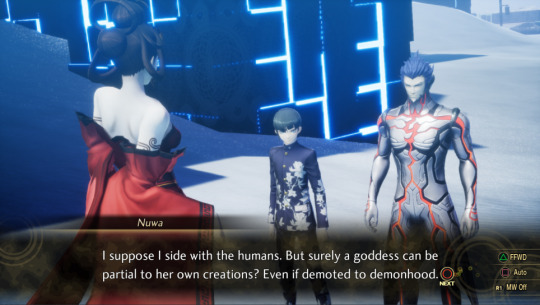
A recurring theme of V is that demons hate their forms. Including Kaneko demons designed to match how they were imagined by people who actually believed in them, like Baal. Nuwa is probably the worst example, since only she makes so few references to who she actually is, and only she is obsessed with her Nahobino pair to such a degree. Zeus, for instance, doesn’t seem to care much than his is dead since he can wait for a new one to be born. However, due to how V setting works, this problem actually implicitly applies to all demons in the game. And this is what I will use to sum up its approach to mythology.
Conclusions: the concept of Nahobino and the future of mythology in Megaten
This post is ultimately redundant because contrary to traditions of the franchise, mythology does not actually matter in SMT V.
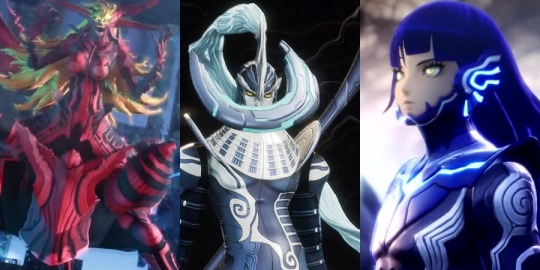
All that matters is the concept of Nahobino, responsible for some of the series’ arguably least coherent, least fitting and least fun to draw designs yet, as seen above. Nahobino, and all associated worldbuilding, have a very simple purpose: strip demons out of context. Their forms depicted in the series do not really matter, neither does their cultural context. Every time a plot-relevant demon is on screen they remind you of that: all they desire is to be able to become a horror vacui monstrosity. Long ago Kazuma Kaneko said that “the most important aspect when drawing demons is to study their creators.” It is undeniable that in the past that was the idea behind the series. While it wasn’t always successful at it (for example due to reliance on rather dubious sources), and sometimes odd liberties were taken, it is hard to deny that it still came from a love for mythology. I do not think this can be said about V, though. Quite the opposite, I think it’s a game which wishes it didn’t have to use mythology at all, moving one step ahead of IVA and SJR, where it felt like the core idea is tiresome subversion alone. Now even that feels secondary, even though the new game still has many examples of it.
I think it’s safe to say the age of myth in Megaten is ending. It will continue to feature enemies and summons bearing names certainly lifted from mythology, but I find it unlikely that it will go back to genuinely caring about it.
Bibliography
Mesopotamian Protective Spirits: The Ritual Texts by F. Wiggermann
Exit Talim! by F. Wiggermann (partially outdated due to Wiggermann’s own research from MPS)
Nihon Shoki
Encyclopedia of Shinto
Rewriting the Past: Reception and Commentary of Nihon shoki, Japan’s First Official History by M. A. J. Felt
Re-positioning the Gods: "Medieval Shintō" and the Origins of Non-Buddhist Discourses on the Kami by F. Rambelli
Duality and the Kami: The Ritual Iconography and Visual Constructions of Medieval Shintō by L. Dolce
Outcasts, Emperorship, and Dragon Cults in The Tale of the Heike by B. T. Bialock
Gods of Medieval Japan vol. 3: Rage and Ravage (extract) by B. Faure
Transcending Locality, Creating Identity: Shinra Myojin, a Korean Deity in Japan by S. J. Kim
The Flood Myths of Early China by M. E. Lewis
Nü Wa by U. Theobald
252 notes
·
View notes
Photo

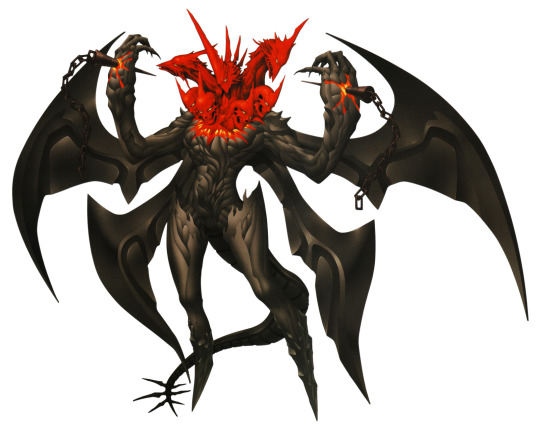
Oh my gosh, SMT5 spoiler time is finally over (as if it really mattered, lol) so I can finally post this stale comparison between Lucifer and Satan. Wow, they got the peg legs and goofy big hands and pose and everything and one’s a robot.
Oh yeah, robot. You know, I hope Doi didn’t make Lucifer a robot because of the existing robot angels as that would miss their point: besides the UFO theme, the humanoid robotic angels (so Metatron, Sandalphon, Victor) exist as artificially-created bodies made by God for the ascended Enoch and Elijah. And Victor as a prototype receptacle for a “voice,” I think because his body is incomplete and inarticulate as if the voice is inhabiting an inanimate object.
I designed [Metatron] as a cyborg because it is said that he was actually a human (Enoch) turned angel. There are a lot of angels who feel like special systems working for God, so I’d say they might have a mechanical side to them.
There is no visual representation left of Victor, since he is only identified as a voice that offered inspiration. This is why I chose to interpret him as a sort of Metatron prototype.
https://dijehtranslations.wordpress.com/2021/11/29/shin-megami-tensei-devill-summoner-world-guidance-angels-and-friends/
Herald Victor The angel who sent the divine revelations to Saint Patrick. It is said you can hear his voice, but not see him, so I made him similar to a robot.
Herald Sandalphon Made to be Metatron’s twin brother. Apparently he used to be human as well. Talking about the prophet Elijah here.
https://dijehtranslations.wordpress.com/2016/08/08/488/
In Metatron’s case, the image I had in mind was not an appearance he had chosen by his own volition, but something mechanic, manufactured to do what he’s told.
https://dijehtranslations.wordpress.com/2016/08/08/kaneko-comments-on-beelzebubs-and-metatrons-designs-in-smt-ii/
32 notes
·
View notes
Text
Digital Devil Story: Megami Tensei II re-review
It’s not uncommon at all for the very first game in a long running video game series to have significant differences from its later installments. Later sequels already have a foundation to work with, and thus have more room to simply focus on adding new features and mechanics, or simply polishing existing ones, meaning that many mechanics and quality of life features that often become very familiar to players and may well be essential to the identity of a series only originated from a sequel. This is the case with Shin Megami Tensei, to an even larger degree than some other series. If one were to ask me where SMT truly began, I would answer with Megami Tensei II, the sequel to the very first SMT game, Megami Tensei, and the predecessor to the proper Shin Megami Tensei I that would be released on the SNES. Along with many mechanics and improvements, Megami Tensei II also brought the series forward in areas like setting, story, and aesthetics. This is honestly a fascinating game to me, and thus, I’d like to take a second look through it, with a re-review similar to what I wrote last time on Megami Tensei I. Before we start though, I’m not going to focus much on core mechanics that already appeared in my MT1 review, which can be found here, and secondly, there will be full game spoilers, for anyone who cares about that. Anyway, with that said, let’s get to it. As with MT1, I played the SNES remake, Kyuuyaku Megami Tensei.
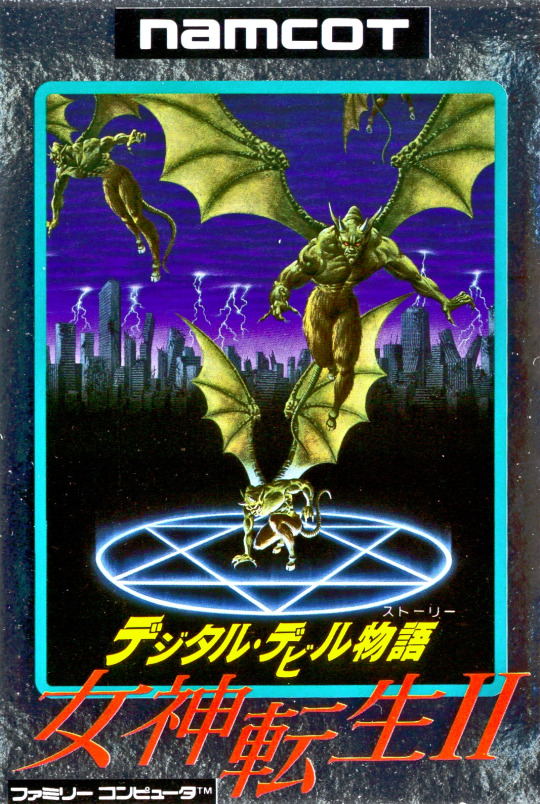
Story:
In the year 199X, humanity was devastated by a nuclear war that destroyed civilization and opened a passage between the human world and the Expanse, leading to demonic hordes quickly conquering the remains of the world and oppressing what was left of humanity. Tokyo in particular was directly hit by a missile, with the demon lord Bael soon establishing dominion over the surface, forcing the survivors to take refuge in the ruins of Tokyo’s wards, or, for the fortunate, in shelters that offer those who live in them safe and comfortable lives. 35 years later, two young residents of one of these shelters, Takuma and Ryu (two characters who are nameable in game and lack default names, but will be referred to by the names given to them in the gamebook Messiah Project 2036), accidentally release a demon called Pazuzu while playing a mysterious video game known as Devil Busters. Pazuzu, who claims to be God’s messenger, declares the two to be the Messiahs who will free humanity from the rule of the demons. In order to aid them in accomplishing this, Pazuzu gifts Takuma with a COMP, a portable device that allows its user to communicate with and summon demons, and grants Ryu the ability to use magic, afterwards guiding them to meet up with one of his servants, Orthrus, and instructing to the duo to kill a witch named Asuka (another nameable character) who betrayed Pazuzu.

Upon confronting Asuka, however, she explains that she believes that Pazuzu merely wishes to replace Bael as ruler of Tokyo, and is using the “Messiahs” in order to accomplish this. While Takuma agrees with her assessment, Ryu, having grown accustomed to the praise and sense of duty that acting as a Messiah has granted him, sides with Pazuzu and abandons the two. Teaming up with Asuka in order to properly free Tokyo from the rule of the demons, Takuma begins to journey through the ruins of Tokyo’s wards, collecting the Seven Pillars of Solomon along the way, artifacts that, when placed at the center of the nuclear missile’s impact, will grant access to the Expanse, and allow the two to take the fight to its demonic rulers, led by Lucifer, formerly imprisoned in ice after his battle with Nakajima, only to be freed by Ryu.
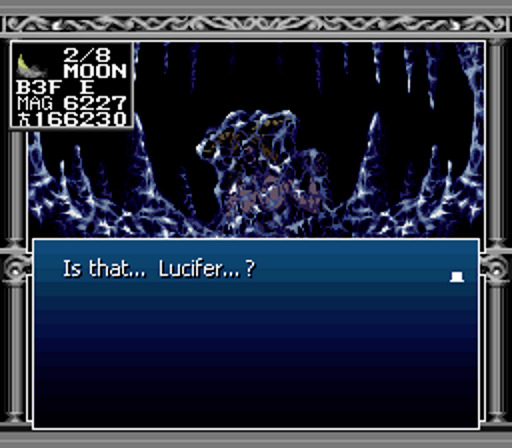
Immediately, Megami Tensei II’s plot is an improvement over the first game’s plot. Most prominently, it establishes the post apocalyptic setting that would become common for the series. That said, for the most part, there still isn’t much plot to be found, as most of what happens are unrelated, fairly random events scattered across all the different locations visited, such as dealing with cults consisting of humans brainwashed by demons, a living island swallowing the protagonists and forcing them to traverse its insides, and even Takuma getting his left arm bitten off by a trap guarding one of the pillars, forcing him to get a cybernetic replacement. Yeah. This is genuinely one of the weirdest games I’ve ever played. There’s also not much really tying it together with the plot of the first game, besides a few references. That said, it does get a bit more interesting towards the end, assuming one is on the path to the good ending, which is where we enter full spoiler territory.
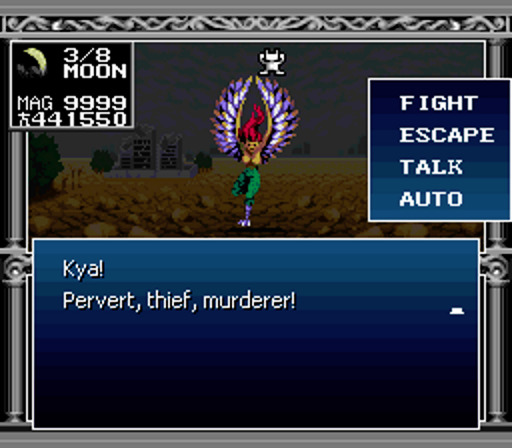
Upon defeating Bael, he turns into a frog that Takuma is able to take with him, and upon confronting Beelzebub, Lucifer’s right hand man, with the frog along, Beelzebub reveals that he and Bael were once the Canaanite god Baal, split in two by none other YHVH/God. After allowing them to return to their original form and traveling through Lucifer’s temple, Lucifer further reveals that YHVH had demonized all other gods in order to ensure uncontested rule over humanity, and that Lucifer himself was an angel cast out of Heaven for giving humanity the gift of wisdom, with humanity proceeding to worship Lucifer himself in the hopes of gaining even more knowledge. In anger, YHVH instructed Satan, his servant and a former ally of Lucifer, to cause the nuclear war and eradicate humanity. Allying with Takuma in order to defeat Satan, they afterwards take the fight to YHVH himself in order to rid the world of demons and ensure humanity’s survival.
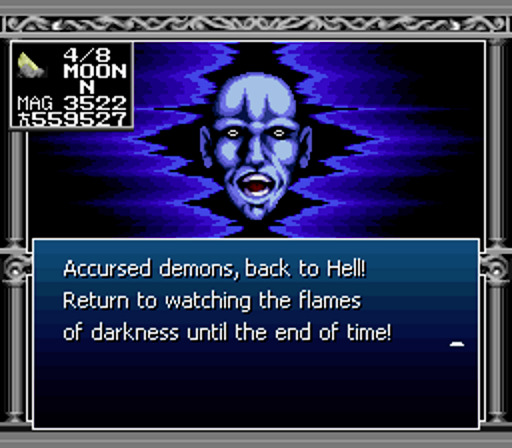
Yes, this game let you fight God before even SMT2 did. In one move, this establishes the central conflict of Law vs. Chaos that would become so important to the series, YHVH’s dethroning and demonization of other deities, establishes Satan as YHVH’s right hand, and Lucifer’s commitment to fighting YHVH above all else. It’s also the introduction of multiple endings to the series, as you can either betray Lucifer at the last moment and join with YHVH, or never even properly ally with Lucifer by instead killing the frog, refusing to fuse Bael and Beelzebub together, or denying Lucifer’s offer of alliance, which instead gives you a bad ending where YHVH gives Takuma and Asuka a home in the Millennium Kingdom, turning the two into gods. That said, it’s all still not as developed as in later games. YHVH is just focused on eradicating humanity outright, the very involvement of the Law faction is kept secret until very late in the game, Satan is just a smug, malicious sycophant lacking any depth, and Lucifer is portrayed as a straight up good guy, rather than being just as dangerous as YHVH. Still, it’s incredible just how many series traditions were added here, and even if the end result is still lacking, I can’t help but appreciate it.
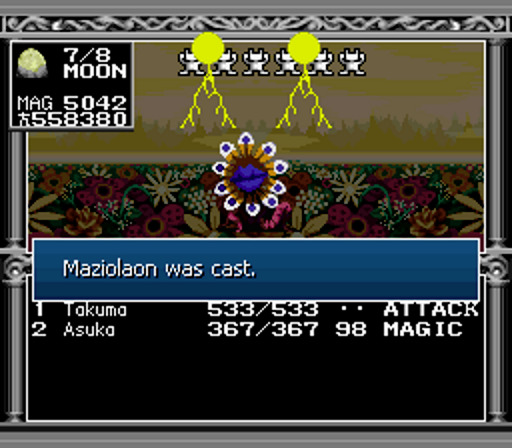
Gameplay:
The basic gameplay of Megami Tensei II is mostly the same as the first game, so I won’t reiterate too many points from there. Probably the biggest addition is that, instead of taking place in one gigantic labyrinth with multiple areas, there’s now an overworld map that allows you to explore the surface of Tokyo and travel to different individual towns or other areas. You can still encounter enemies on the overworld, and in fact the encounter rate for it seems even higher for it than normal, but magnetite isn’t drained even while you have demons out, which makes it much easier to get from place to place. This overworld does a lot to help the pacing, as there’s now many more locations to visit, meaning dungeons are much, much shorter than in the first game. In addition, instead of saving the game at village elders, terminals have been added, which perform the same function, but also allow you to teleport between them, making it so much easier to backtrack or get to different areas if, for instance, you’re looking for specific demons to use for fusion. Buildings and other areas within towns will still have random encounters if they’re explorable, but it’s still not too bad to deal with.
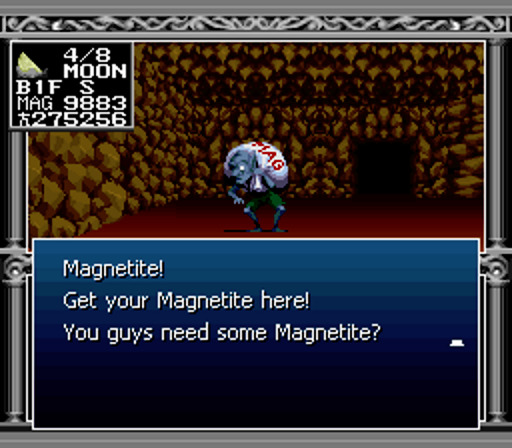
Combat isn’t too different, but there have been some additions. Most notably, guns are now a separate weapon for the humans to use, though unfortunately they’re pretty underutilized. They’re more effective against enemies made of flesh and blood, with melee weapons being more effective against enemies with thin or intangible bodies instead, and in the early parts of the game, this dynamic holds up. Later on, however, guns drop in effectiveness pretty hard, and while they do generally still hit more enemies per round than melee weapons, you’ll soon find yourself switching to melee full time. On that subject, shops no longer sell melee weapons, instead only selling guns and armor, leaving melee weapons to only be dropped by enemies, which is a system that honestly just frustrates me. Luck now apparently increases drop rates from enemies, but on average, it seems to be pretty rare for them to drop anything, which is pretty terrible when you can’t even find weapons in treasure chests, with only three weapons total being given through events, all of which are near the end of the game.
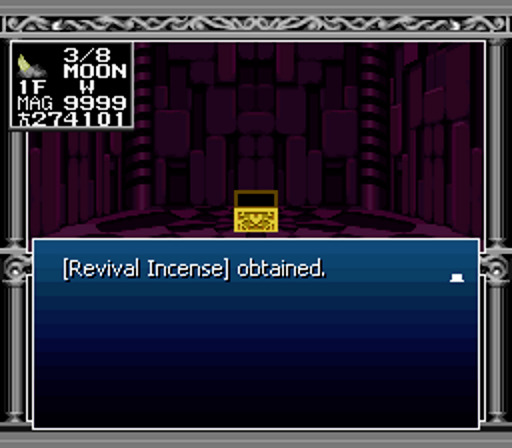
Armor now does more than just increasing defense, and different categories of it give boosts to one’s stats. Helmets typically increase intellect, gloves increase strength and occasionally vitality, boots increase speed and occasionally strength, and capes, a new category of armor, increase luck, with these boosts applying even if they go past the natural stat cap of 35. Some pieces of armor also give resistance to certain elements, further increasing the protection they give. This is all great, but it’s contrasted by a horrible, horrible increase in price. Money is already pretty tight in this, what with needing it to summon demons in the first place and pay for healers, and equipment is so expensive that it actually feels like you aren’t even expected to get more than a few pieces across the whole game. Even abusing casinos, which are more common than in the first game, and the sole source of capes, at that, every new shop you come across will quickly drain you of everything you earned. I really don’t understand what they were trying to do with this, but when you price equipment for over 100,000 macca by the end of the game, when enemies barely drop anything and even casinos will only earn you about half of that per round, you’ve screwed up somewhere. There’s also a few pieces of equipment, namely Lucifer’s armor, the best armor in the game, and Lucifer’s sword, one of the best swords in the game, that actually have stat requirements, with Takuma needing 20 base intellect to equip Lucifer’s sword, and needing 30 vitality and 25 intellect to equip Lucifer’s armor, though stat boosts do count in this case, saving you at best 2 points of vitality and 4 points of intellect with the best gloves and second best helmet. If you know about it in advance, it actually gives a nice incentive to level intellect on Takuma, since it might otherwise seem pretty pointless if one doesn’t know about its effects, but considering these are given at the end of the game, someone playing blind will find these pretty nasty surprises

In terms of other improvements when it comes to combat, spells have been added and even overhauled a bit. Buff and debuff spells are more common than in the first game, and they do have a noticeable effect as long as you cast them twice, and demons overall generally come with a nice spread of supportive spells to help make your life a bit easier. Asuka’s selection of spells is pretty different from Yumiko’s from the first game, learning Zio spells instead of Agi spells, which is much more useful, and learning Traesto and Tranpa, letting her teleport the party out of dungeons and teleport back to the last used terminal respectively, making getting around even easier. Incenses, the stat boosting items in SMT, have also been added, with 5 total incenses for vitality, intellect, and strength, 4 for speed, and 6 for luck scattered throughout, less than in later games, but still enough to give some nice boosts. There’s many more bosses than in the first game, all of which give pretty great amounts of EXP and help spice things up just a bit, and some even belong to optional side areas. There’s also a proper tutorial, in the form of the Devil Busters game, which introduces overworld movement, demon recruitment, and gives actual explanations about many mechanics, such as moon phases, fusion, magnetite, and what stats actually do. Additionally, there’s no negative consequences for dying in Devil Busters, so you can just continue afterwards. It’s a much kinder introduction than one would expect, and it’s extra neat to play because it’s actually based off the Tower of Daedalus, the first dungeon in MT1, down to the music.
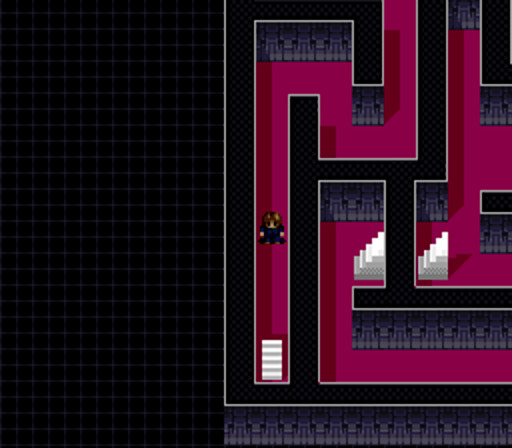
However, the most interesting additions and changes are those made to the demons. As before, they’re still only sorted into evil, neutral, and good demons, with neutral demons being recruitable from random encounters and good demons being fusion only, but the amount of them has been expanded pretty nicely. The first game only had 142 demons total, with 65 of them being neutral or good. MT2, on the other hand, has 250 demons, with 121 of them being evil, 64 being neutral, and 65 being good, meaning there’s actually a few more useable demons than enemy only ones. Obviously, this increases the scope of it drastically, and ensures that almost every level Takuma gains opens up another demon or two to use. Demons also have much more focused stat lines, with many of them focusing on stats like vitality and strength at the expense of speed and intellect, for instance, which theoretically makes them more focused than the very balanced stats that good demons in MT1 would have by the end. Unfortunately, this actually just hurts the viability of many of them, especially those with low intellect, as many bosses in the Expanse and endgame have very damaging spells that will wreck anything without high intellect. There’s also several demons that can be acquired through events, with them often being unique and usable regardless of level, which is very helpful.
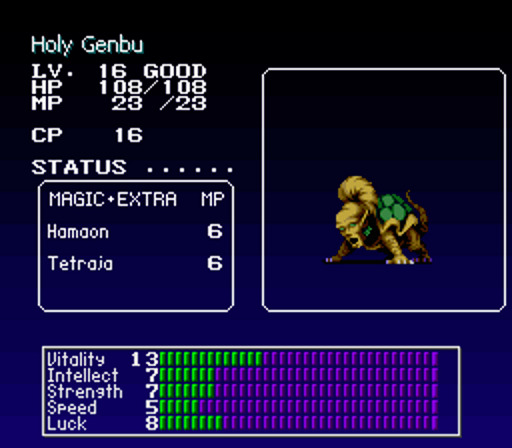
The mechanic related to demons that was overhauled the most, however, is fusion. Most importantly, instead of needing very specific demons to get specific results, like in MT1, the much more familiar formula of the races of the demons used plus the average of their levels determining the result is introduced, with the result always rounding up if it isn’t exact. This system is much more forgiving and easy to use than the first game, and it’s made even better through the proper introduction of elements, who, when fused with certain races, will always make the result the next highest demon in that race. For instance, fusing Salamander with an Avatar demon will always result in the Avatar above the Avatar used. Since demons still don’t level up, and there’s no skill inheritance, there’s no downsides to using elements, so you can keep your demons upgraded throughout the game pretty easily, if still tediously. The only races that can’t be upgraded through this method are the Fairy, Element, Divine, and Deity races.
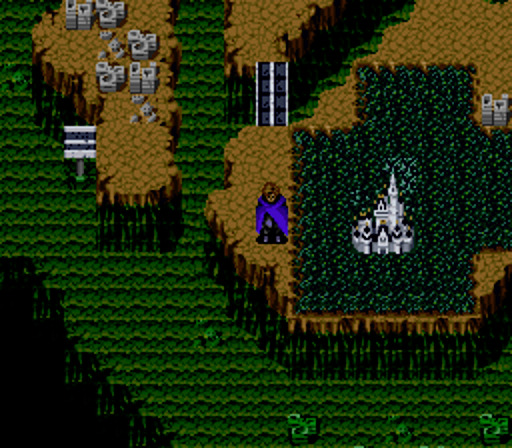
Also introduced is triple fusion and special fusion. Triple fusion can only be performed with good demons, and obviously uses three demons at once, compared to the normal double fusion, which uses two. Special fusion deviates from the normal formulas and produces special results when fusing specific demons together. These aren’t too important usually, but the Kishins Zouchouten, Koumokuten, Jikokuten, and Tamonten can be made through special triple fusion in addition their normally much harder requirements, Divines can only be made through triple or special fusion, and Deities can only be made through triple fusion, with the ultimate fusion demon, Shiva, only being obtainable through triple fusion using some of the strongest demons in the game.
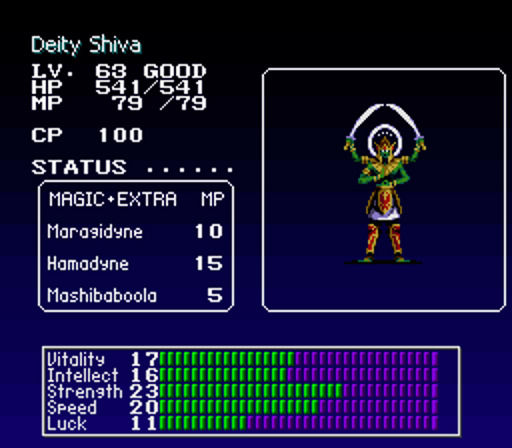
While most of this is much better designed than in the first game, there is one bizarre series of occurrences that I really need to go on a tangent about, that being everything to do with the Divine race. Consisting of Uriel, Raphael, Cherubim, Nike, Gabriel, and Michael, as stated above, they can only be acquired through triple or special fusion, though in actuality, Cherub and Nike seem to be the only ones acquirable through normal triple fusion, and even then, only if you’re clever. The archangels all require special triple fusion with elements, Cherub otherwise requires a fusion of Sword Knight, a one time event demon, and Sylph, and Nike requires Valkyrie fused with Ocypete, Aello, or Celaeno. The problem with all this is that, by the time you can do most of this, they are horrendously outclassed. Uriel and Raphael, level 13 and 20 respectively, both require Salamander, a level 38 element, Sword Knight is far better than the level 27 Cherubim, and Valkyrie is level 57 and only appears in the second to last dungeon in the game, at a time when the level 35 Nike has long lost its uses. Most of these mentions demons have poor stats even for their levels, and the only real advantage they have is Samarecarm, a resurrection spell that is worth far less than the developers seem to have thought. Gabriel and Michael are actually quite good, with Michael in particular being viable even to the end of the game, and are much easier to acquire, which really makes me wonder what the devs were thinking with the rest of this race.

In one finally note in regards to the gameplay, there’s actually a fair amount of easter eggs that can be accessed in the SNES version of this game, with most of them only being accessible if one played through MT1 first and did certain actions there. These range from Izanami giving you a robe that allows you to safely cross damage tiles if you gave her silk thread in MT1, being able to acquire a restorative item from Rag’s shop if you entered it at least twice in MT1, which combined with a piece of equipment you can win at casinos, allows you to acquire Qing Long, Bai Long, and Kali, three endgame demons, for free at any Cathedral of Shadows, to, most prominently, gaining access to three small bonus areas if Bael is killed as a frog, wherein you can find Artemis, Leto, and Apollo, three demons exclusive to this version who can then be specially fused to make Zeus, who has a hilariously bizarre design in this game. It’s pretty cool, but all these exclusive demons, Zeus included, are just copies of other demons statwise, most of which are acquirable through the good ending route for free, and since you have to lock yourself into the bad ending to access any of this, it’s a novelty at best.

Overall, the gameplay of MT2 is much more refined than its predecessor. The improvements to fusion and the addition of the overworld alone helps the pace a ton, and makes for a much more fun game. That doesn’t mean it doesn’t have moments of bad design, as the encounter rate actually feels even higher than in the first game, and the Expanse has some miserable areas, mainly the Forest of Confusion, which contains several caves the COMP doesn’t work, preventing you from summoning demons within them or even using the automap, and also contains Astaroth’s castle, which starts with Asuka being kidnapped, forcing you to trudge through the entire dungeon and fight Astaroth himself without your dedicated healer. It’s horrible, needless to say. All the same, though, I did have some amount of fun with this game’s gameplay, which is more than I can say about MT1.
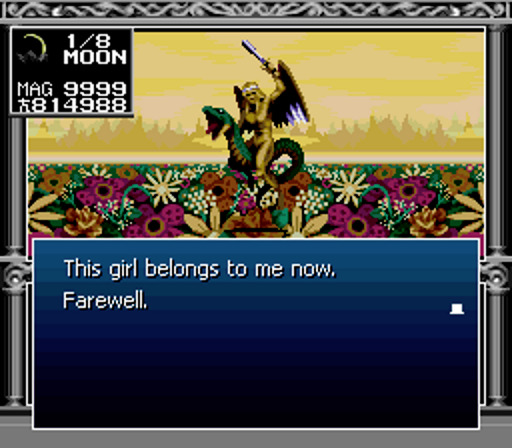
Graphics:
The visuals of MT2 are actually a good improvement over MT1. It still has the same bland, repetitive dungeons, but the overworld is actually pretty neat to look at, giving the main character a pretty cool looking sprite, and both Tokyo and the Expanse look properly gruesome to explore. As for the demons, the visual highlights of most SMT games, they’ve been improved as well, courtesy of Kazuma Kaneko, the series main artist, actually working on this game, unlike MT1. This means many demons now have much better looking designs, with many of them looking plain cool, and compared to MT1, which had many, many of its sprites changed for the SNES version, MT2′s SNES sprites are much closer to their original versions. Many demons, such as Lucifer, YHVH, Astaroth, Barong, and Girimehkala have designs pretty close to their later, more iconic ones, and so many iconic demons were introduced in this. In addition to the above mentioned ones like Shiva and the Archangels, Pixie, Vishnu, Pyro Jack, and even Jack Frost himself first debuted here. That said, several designs, like Beelzebub and Satan, are much more different, and there’s still plenty of weird demons, like man eating plants, several directly based on the Coin, Wand, Cup, and Sword minor arcanas, and even several possessed humans, based on heavy metal fans and Jason Voorhees. I’m not kidding. Still, it’s a significant step forward, and makes for some cool enemies to fight.
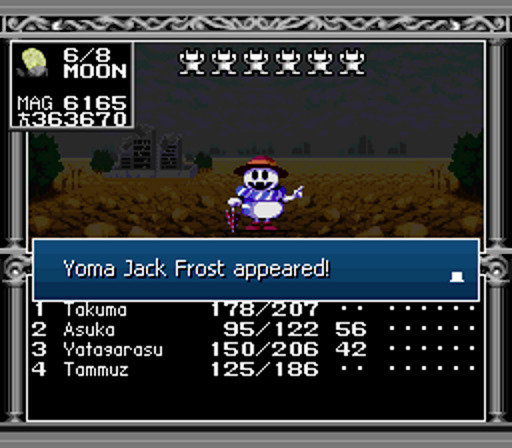
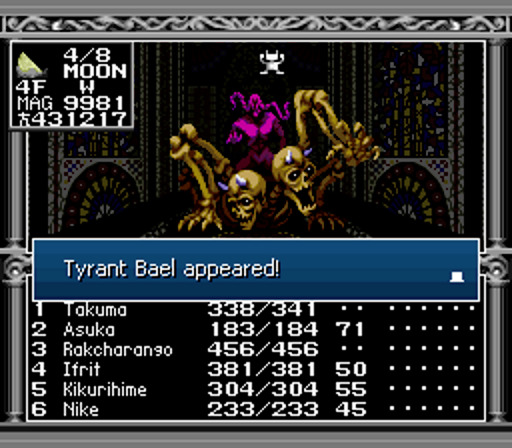
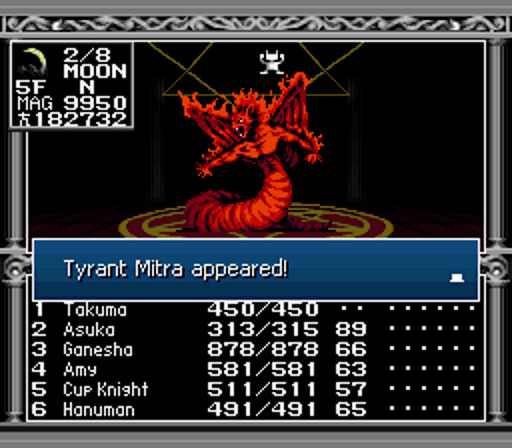
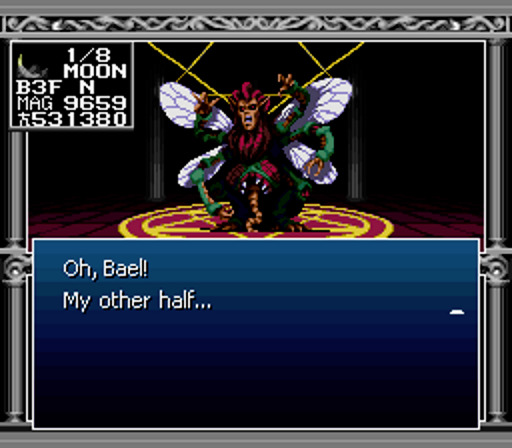
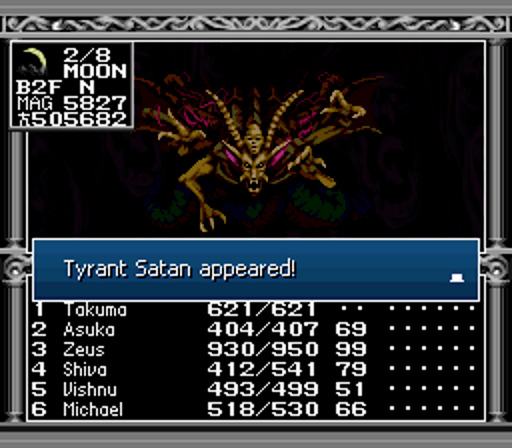
Music:
The soundtrack to MT2 is also an improvement over MT1, which already had a decent soundtrack. The main reason for this is that the cartridges used memory mappers that included extra sound hardware, resulting in the original Famicom version of MT2 having one of the richest 8-bit soundtracks ever, courtesy of Tsukasa Masuko, a soundtrack which was very faithfully remixed for this SNES version. From the rocking battle theme Death Match, to Explorer, the theme for exploring buildings in Tokyo, to the overworld theme for the Expanse, Hallucination, and especially OMEGA, the boss themes for Satan and YHVH that even has different mixes for both of them, it’s a joy of a soundtrack to listen to, and it’s worth a listen even if the game itself is unappealing to you.
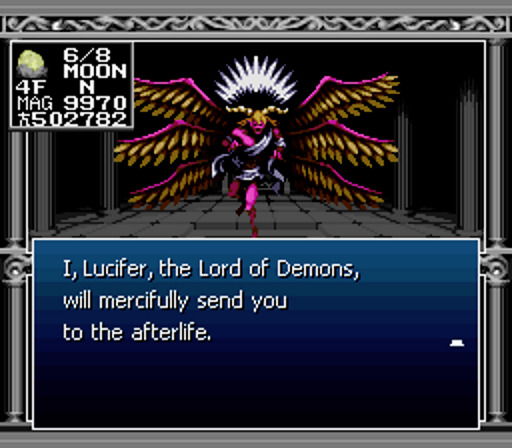
Conclusion:
Overall, Megami Tensei II is unfortunately still not a game I can recommend. It’s a big improvement, absolutely, and I’d even say it’s up there with Dragon Quest III, Dragon Quest IV, Final Fantasy III, and MOTHER in terms of the best designed Famicom/NES RPGs. However, best designed is only relative. It’s still grindy, frustrating, obtuse, and cheap as hell. It’s much more playable than Megami Tensei I, but still undoubtedly more than most would be able to handle. That said, if you’re really, really interested in the very beginnings of SMT, this is worth a look, at least. It properly set down the foundation for one of the biggest RPG franchises today, and it’s still impressive to see how much it did.
With that, we’re finally done here. With my replays of these two relics out of the way, I can finally move into new territory with this series, and I’m quite excited to do so. I can actually say with confidence I’ll be playing a lot of SMT this year. Till next time.
-Scout
10 notes
·
View notes
Text
Something I’ve been thinking while playing SMT V (potential spoilers ahead)
NOTE: I’m currently about to fight Yakumo for the first time and I’ve been doing my best to avoid seeing spoilers.
At the beginning of the game Aogami says something along the lines of, “I have a mission to protect you.” When I first heard that I just like, “Of course, that makes sense. Find and protect the messiah.” Then when the Lucifer flashback happen and I thought, “Well, I guess this is similar to the situation that happen in SMT II. Where the law faction is trying to control the messiah to create their ideal world.” So, everything goes smoothly, we save find Dazai, return to the Tokyo, and Abdiel gets mad at us.
At first my thought was, “Huh… I guess she didn’t know. Must have been a secret or something.” Then I thought about for a bit, “Wait… WHY WOULDN’T SHE KNOW ABOUT SOMETHING IMPORTANT LIKE THAT?!” Because if Aogami’s mission was to find and protect the messiah, wouldn’t there been a lot of joy in Bethel with Aogami completing his mission of finding the messiah and protecting him (even if he went about it the wrong way)? Plus, would have that been made obvious by Koshimizu or Abdiel to the protagonist that he is the messiah because Bethel didn’t hide from Tao that she was The Saint.
Then the Lahmu situation happen and he said that the nahobino is made when each half of a soul is reunited with each other. So I’m thinking, “Wait, is Aogami half of a messiah?” Because if that is true, then why didn’t make a full messiah? WHY ONLY HALF? In SMT II, Aleph was a full messiah and the law faction in that game didn’t have trouble creating him with their technology. So, why did Bethel only create half of a messiah? I feel like Bethel would be capable of creating an artificial messiah if they are able to create the proto-fiend, so why didn’t they do it?
My guess on why they didn’t it is because even if you create an artificial messiah, you can’t really control their actions (as seen in SMT II, you are not bound by the law faction). Though in order to change the world, you still need some of that messiah power (I guess?). So my guess, in order to create a perfect law messiah, Bethel split the messiah’s soul and tossed out the Knowledge part of it (since that’s what dictates choices and what could make their plan fail). Then shoved the other half into the proto-fiend and started doing experiments/battles to figure out how to make him change the world in order for him to be the new god of order. I’m assume the experiments they are doing relate to trying to recreate the Demi-fiend’s power, since he’s one of the most powerful characters in Megaten. The reason Aogami was given orders to protect the protagonist is that Bethel needed a backup plan in case they couldn’t figure out how to make Aogami the god of order (though if it work out, I guess the protagonist would be his goddess instead or something) and needed to use a nahobino instead. Which would explain why Abdiel got mad at the protagonist when returning from Da’at because it wasn’t part of the initial plan for them to fuse. I assume Aogami probably knew this at some point, but due his memory getting corrupted he didn’t remember and accidentally initiated plan B instead.
Though, I guess Bethel Japan decided to keep the nahobino around because they’re lacking in resources and don’t really just want to have just Aogami’s power. If I end up being right, I wonder how Bethel didn’t find the protagonist at all. Scratch that, they probably didn’t find him since he lived a average life and lived a quietly before fusing with Aogami. If I remember correctly, The Center didn’t find Aleph in SMT II after he had gone missing from them until he won tournament and got noticed by them. Plus, there also seems to be no way to tell if you inherited Knowledge of a powerful god as far as I know.
Edit: I just realized after typing this whole thing out, this might explain why the protagonist appears more feminine than in this game than in other games and isn’t just a reference to Digital Devil Story: Megami Tensei novel (I saw somewhere that Nakajima was feminine looking in the novel and reading the description of the ripped manga, I don’t think Atlus forgot about the origins of Megaten). Since the messiah lost his power, he can only have the strength of a normal person.
2 notes
·
View notes
Text
Sociopath Profile: YHVH

From the Shin Megami Tensei series Appearances: Shin Megami Tensei I (1992), Shin Megami Tensei II (1994), Shin Megami Tensei IV: Apocalypse (2016) Voiced by Mugihito (JP) and William Salyers (EN) Requested by an anon
The makers of the series stated that this was not intended to be an accurate depiction of God, and more a show of how things are going severely wrong in the universe. And regardless of what you think of religion, you can definitely say that’s true. SMT makes Him out to be a ruthless totalitarian who looks down on His creations for some of the pettiest of reasons.
[SPOILERS BELOW]
It’s easy to have a grandiose sense of self-worth when you are literally omnipotent. YHVH has an extremely inflated opinion of Himself and He thinks that His brutal version of law is best for everyone. However, He does not consider the thoughts of anyone else who thinks that He may be going too far.
"Praise my name! Witness, bathed in the glory of my countenance! Praise my name!"
He only cares about His own grand vision and only wants to control everything for Himself. The lack of empathy He has for His creations is staggering in this series. The only worth He has for them is to provide Him with prayer to keep Himself powerful. And He actively goes against what His followers desires for utopia in favor of a dystopia where He is in charge. The plot is Him attempting to wipe out humanity, but it isn’t the first time He has done this.
He uses humans, angels, and Lucifer as chess pieces for His vision. He doesn’t care about any of them and will use them without a second thought. He sees mortals as slaves or tools and possibly sees angels the same way. The fact that He is willing to allow the militant Messian gangs to wreak havoc after unleashing a nuclear winter, knowing it would pave the way for His vision.
As the makers noted, this depiction of God is used to show that there is something wrong with the fabric of the SMT universe, implying that He wasn’t always this totalitarian. However, with what happened to Him, He became a remorseless being who would raze the world just to get His way. He doesn’t show any compassion for what He has created or the people loyal to Him. He even says that he will create a “new world filled with my thralls.”
SMT Sociopath List
#YHVH#Shin Megami Tensei#Megami Tensei#character analysis#profile#Not quite complete. I just wanted to get this one out finally.#major spoiler
15 notes
·
View notes
Text
Wip masterlist
Click read more to see some of my wips. Many are in very early stages, others (one of them) is currently in the second draft
And as y'all can tell I haven't even come up with most of the names smh
Fallen gods
CW: death, gore
Like everyone else, I too have a story where some irresponsible people mess with gods
There's this lil bitch that is doing a weird research and...then he dies for reasons (all of his friends are witnesses uwu)
So main character that is lil bitch's best friend finds the notes about the research and brings him back. Obviously he's not fully alone
So things go as the now rencarnated friend is wild and tried to do things like murder and robbery
His friend group is all like: ah ah ah u so sexy don't do that or... We might have to kill you again luv
Anyway mc has a chicken as a pet. And they take very good care of her!
To be honest there are a lot of things about this that I still need to work out
The vibe: snow filled roads, street lamps illuminating empty roads, cozy knits, blood on whispering woods
Storyboard ii
Mc has his personality/body stolen. Basically he looks like a Chad now and sometimes he thinks and acts like one too. Truly tragic I know 😥
The inspiration for that came to me on a history class where we were discussing Greek art... Don't remember how I actually came up with it lmao.
Anyway MCs friends r helping him get himself back before he looses his own memory and is stuck as a Chad forever
The setting changes from our world and a different sorta of fantasy world
It's about friendship👌 and betrayal 👌
Characters r: Logan, our Chad that just wants his memory/personality back so he can be pretentious again
Jedi, Logan's best friend that just wants her childhood best friend back
Twins, basically the ones with the biggest connection to the magic world, I won't say their names bc now I think they r cringy and I want to pick new ones
Joshua, the smart one intellectually but makes dumb choices when it comes to real life.
Nicholas, I don't want to say that he's the baby of the story but he's definitely my baby. Honestly too scared of everything and he just wants to hold a hand. He's still in highschool (he's in his last year whereas his friends r on the 1st of uni) and he feels left behind
"even a worm will turn"
Vibe: green and blue neon lights, abandoned churches, a thin line of smoke, vintage books with annotations
wlw period drama
I actually came up with this some days ago.... It's a really funny story but I'm not telling it now
Anyway mc is lonely and stays at her house most of the time writing stories and poems
Her sister is usually traveling bc she's a scientist or smt ejfnfjf
Then one day her sister comes back to their home and brings a scientific artist with her
The sister has to leave for one afternoon so mc has to show the artist around her house. They end up in a meadow near a lake painting and writing poems and sorta of get feelings for each other
When the artist goes back to her country they keep exchanging letters and falling in love one word at a time
Vibe: wild flowers, white linen sheets, countryside, rivers but in a nice way!!
Superhero story
I pretty much have everything figured out about this story but the villain so
Half of the characters are unhinged and just do what I wish I could do :'( like set their abusers on fire figuratively and mentally
I honestly don't know how to speak about this without giving away major spoilers and there are a lot of povs so... Yeah it's a talk for another day
cloves and bread
Inspired by a childhood tale and a myth:-)
Dragons, rich girls and kings
Burning woods
Lots of dissosiatian
Mc hears voices from the woods (when he was young the fey tried to kidnap him and he sorta of stayed linked to them)
It mostly deals with mc feeling crazy and wild things happening
There's also a mysterious love interest
Autumn knight
Mc's sister goes missing so mc goes looking for her
She is my bby but I have planned 1% of this wip smh it shouldn't even be here
Sleeping wolves
I watched too many Ari aster movies and a lot of heist movies and then I was like ok luv
The concept is eat the rich but in a really wild way and part of the reason why I did the mc characters white and male was because I'm afraid people will look at the story and think these characters r doing what they r doing bc for example they r crazy emotional women(yes people still think that unfortunately) so by being male I really want the reader to get that perhaps they r just crazy and r using the eat the rich as an excuse for what they do
Mc is lost in life bc his brother was missing for a while and then he was found dead
Then he gets closer with a weird group of people
They go apeshit and uhmmm
And uhmmm maybe one of the characters took eat the rich a bit too literally
I don't want to talk about this rjbghff it's a mess luv
But it actually sounds better when u read it bc like half of these things r supposed to be... A "surprise"
#one day ill make peoper aesthetics and intro for these wips#idk i just wanted to post and didn't know what to post#writeblr#wip#writers of tumblr
2 notes
·
View notes
Text
Bae made me start daiya almost an year ago and I really grew fond of the characters and today I want to share my opinion about Miyuki because I really care about him. I relate a lot to his character and lately I’m so disappointed in his “””development””” in act ii because his character feels??? So off???
Please, this may contain spoilers of the manga so pay attention!!!
And please, don’t kill me. I don’t want to start a discourse and I’d love to talk about these with you all so just? Be kind please?
Miyuki lacks of communication skills, honestly. We know that, we’ve seen that in so many occasions, but in the first manga his development was more about learning how to feel a part of his team and how to guide Seidou through actions more than through words.
This was his development in the first manga and honestly I’ve always felt like he was going to overcome his lack of communication skills but? Why it didn’t happen? Why when Furuya was having difficulties in his last match as the ace, Miyuki barely looked at him? Why when Sawamura was in the middle of a crisis in his first match as the ace, Miyuki didn’t say anything? Yeah, I know he scored a homerun like,,,some minutes later (and don’t let me start ranting on him scoring homeruns every time his team is in danger as if he’s the god of homeruns or smt like that bc this is becoming more and more annoying to me) but? Sawamura needed words, maybe? Furuya too? And we didn’t have anything? Where was he?
I don’t even care if Terajima has showed those things off-screen because it doesn’t count. We deserved to see them, not to suppose they happened. We can’t suppose everything. Miyuki needs to grow, he needs to learn how to hype up his teammates and his pitchers. Because he’s the catcher, and the captain. And because he’s this soft guy who really cares about his team and would do anything for it, even trying to overcome his poor communication skills.
Like,,,we’d have this teenager trying so hard to reach people with reassuring words, trying so hard to understand and be understood and instead we have this character that apparently is perfect and doesn’t need anything else
That’s not the Miyuki I fell in love with in the first episode
#daiya no ace#miyuki kazuya#ace of diamond#diamond no ace#opinion#pls don't kill me#miyuki is my fave but sometimes he feels so off and that makes me sad?#i really think terajima is ruining him sometimes#like#he seems a completely different character to me#miyuki i miss u#i don't have anything to promote but please stan mimamiyu#and bae i love you so much
18 notes
·
View notes
Note
Favourite SMT final boss?
smt ii, nocturne, iv, and apocalypse spoilers below
ahh i like kagutsuchi and baal in nocturne and maybe yhvh in smt ii and apoc. almost all of my favorite boss fights are in nocturne, though i think ancient of days in iv is underrated
4 notes
·
View notes
Photo

“My beloved younger brother… You hate me, don’t you? In the depths of your heart, you want to kill me, right? … Tell me how you feel. Don’t you hate me?”
“My hatred knows no bounds.”
#devil survivor#devil survivor spoilers#LIKE MAJOR SPOILERS LMAOOO#naoya minegishi#naoya#kazuya minegishi#my art#me: it's just a background no one is going to care about the fine details#also me: put every face of babel on the center column lmao#anyway i just wanted to draw my favorite boss fight :')#and by 'favorite' i mean most fucking painful#i just really really love the idea of abel only choosing to become the messiah because he knows it'll kill naoya#kazuya doesn't give a fuck about humanity's wellbeing#he only wants to make naoya suffer#and i know this is incongruent with amane's 8th day but hey#i would have loved to option to just tell naoya to fuck off and doing so would lead to a more smt-traditional type of law ending#where rather than ceding control to okuninushi#abel would rather just destroy it all and metatron creates a 'tokyo millennium' kinda thing like we saw in smt ii#because more than anything naoya really wants humanity to be free#and this betrayal to humanity is just one more giant 'fuck you' and way to hurt cain#okay i'm rambling and this is something that i really should put in a separate post#anyway#i obviously am very chaos heavy in this game but the law route is such an emotional gut punch that i just.. needed to draw it#desu
81 notes
·
View notes